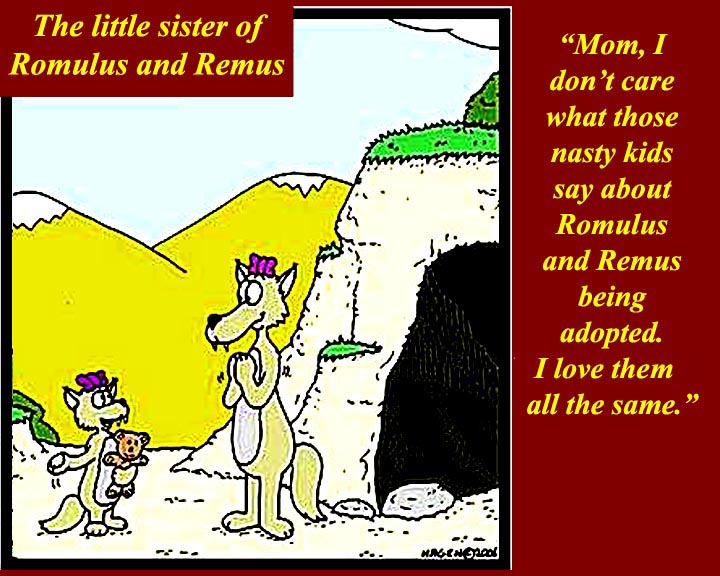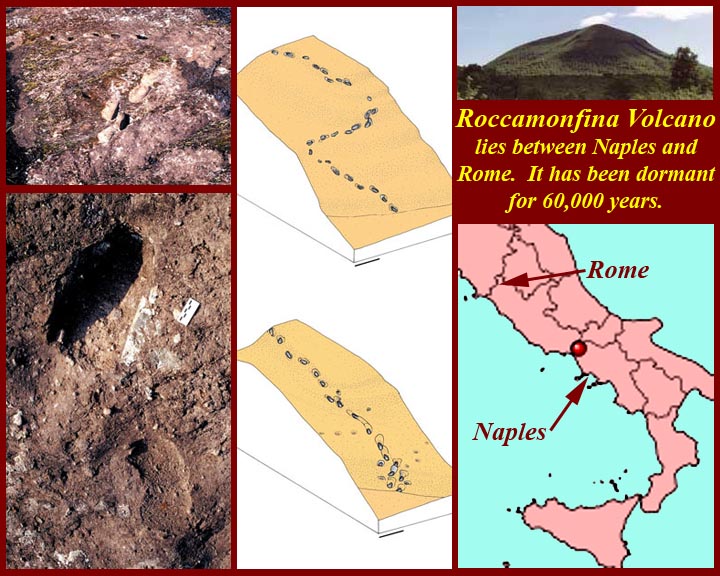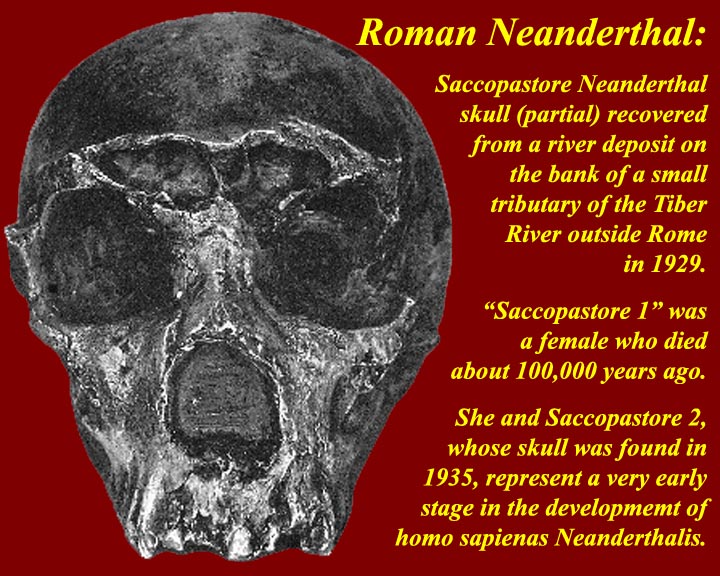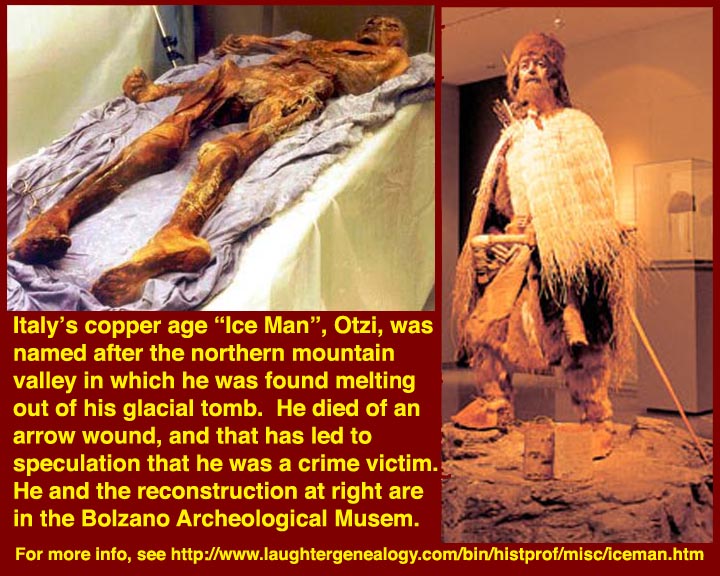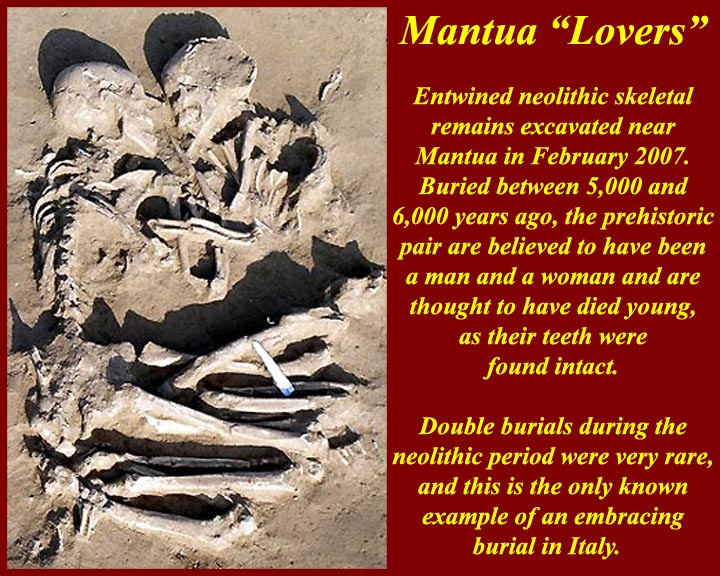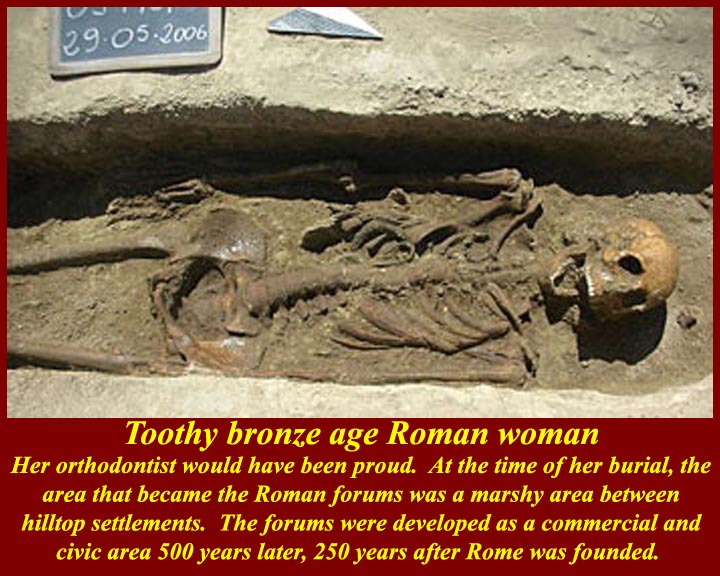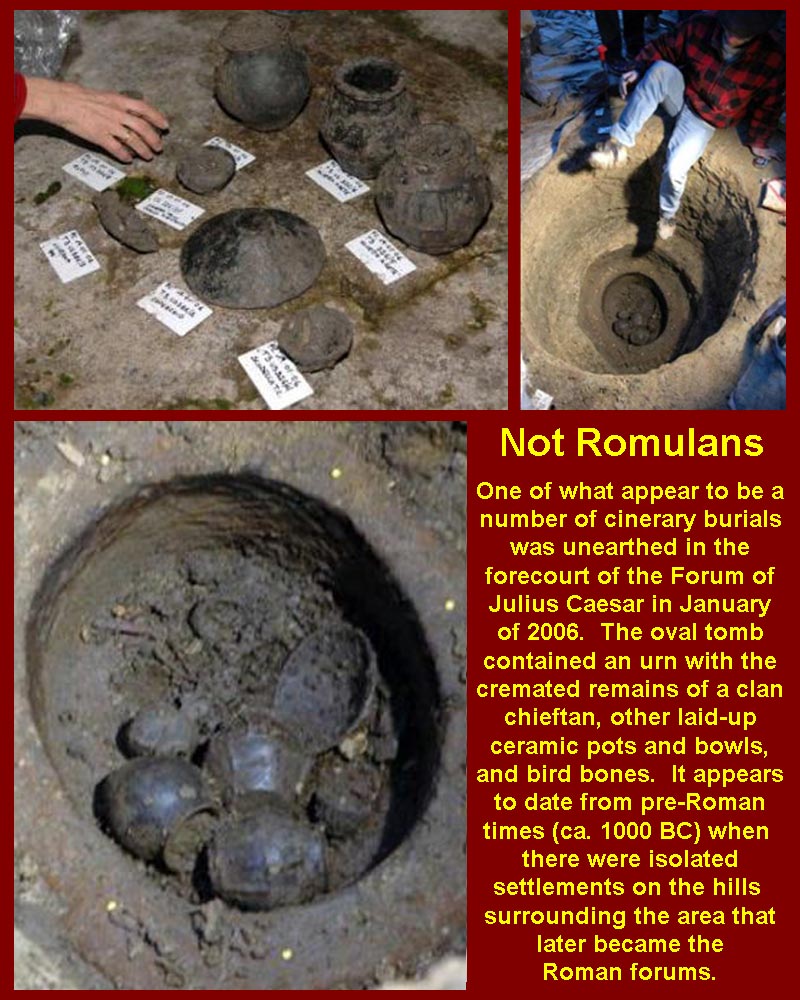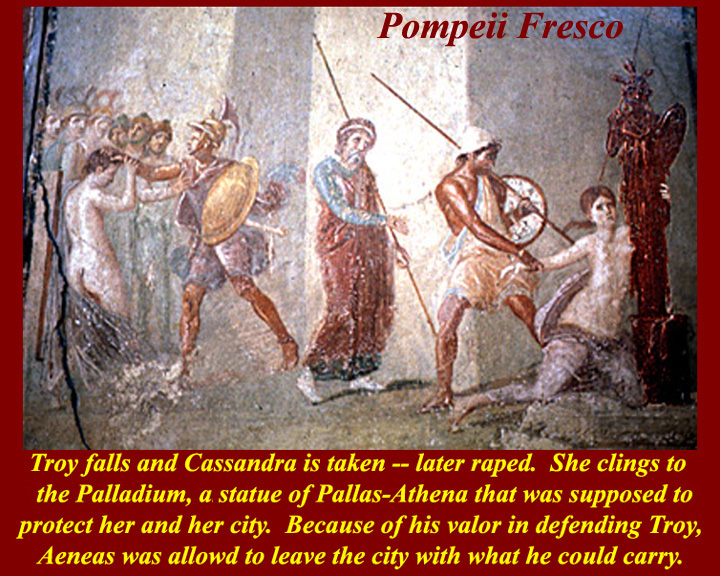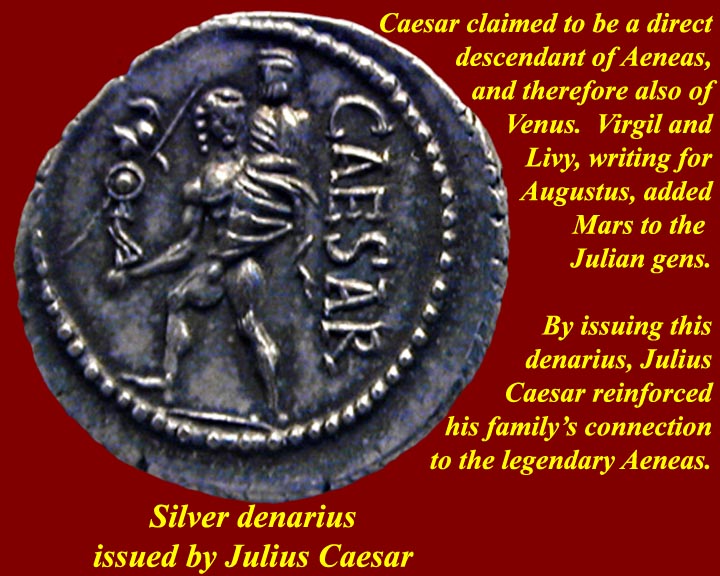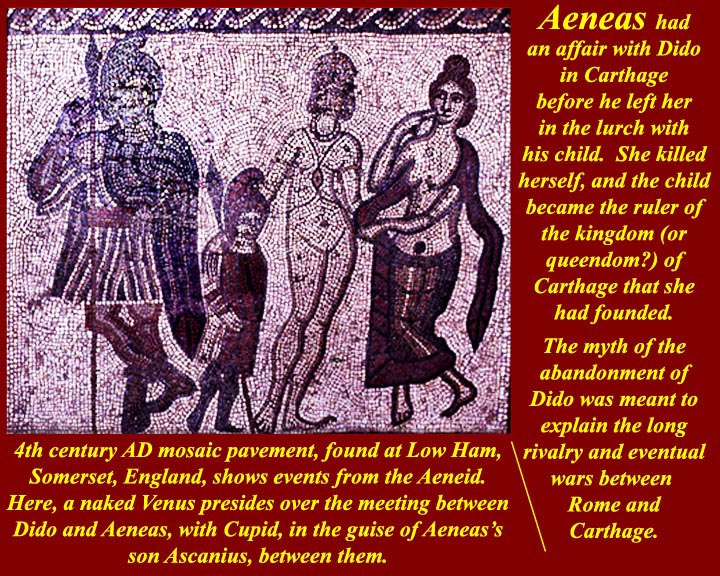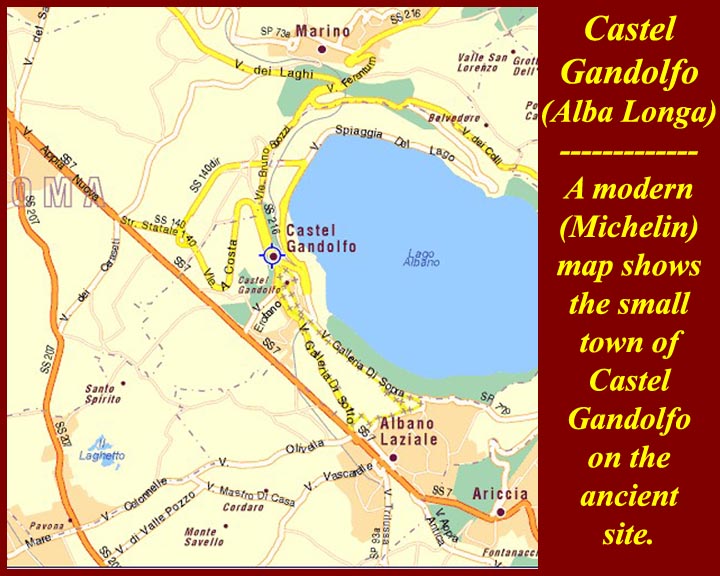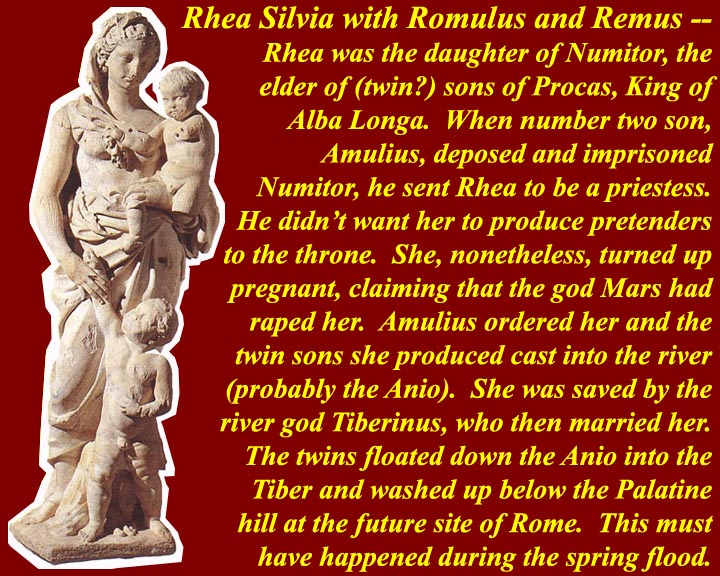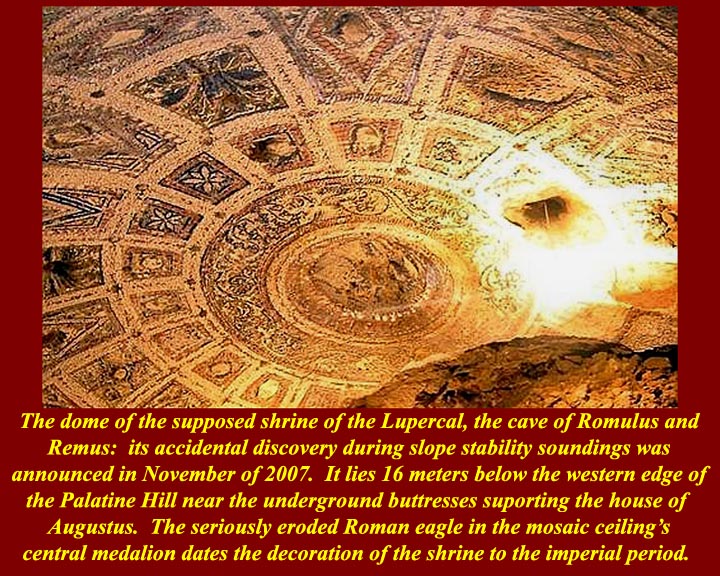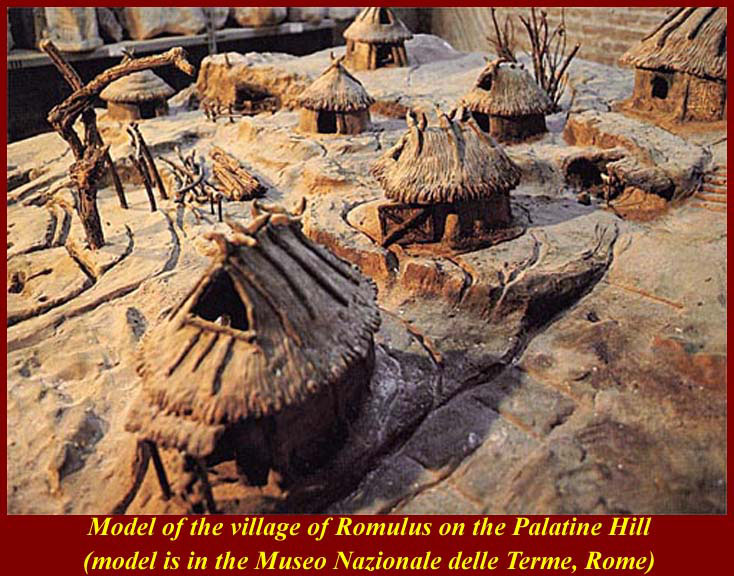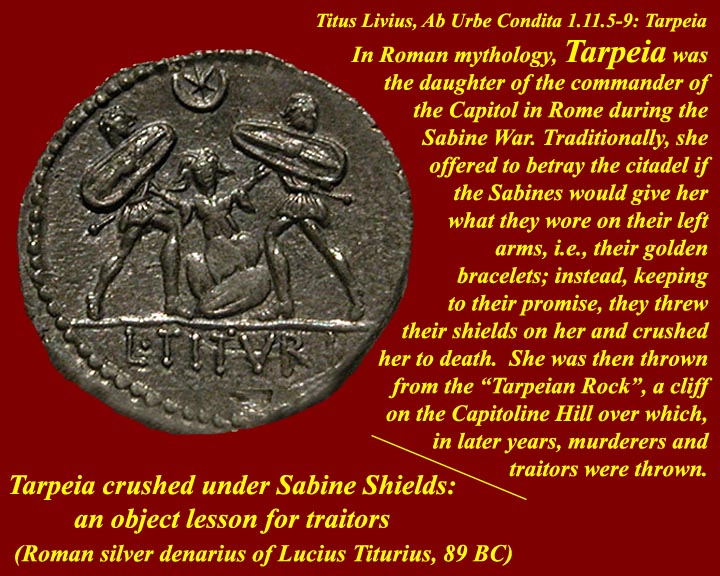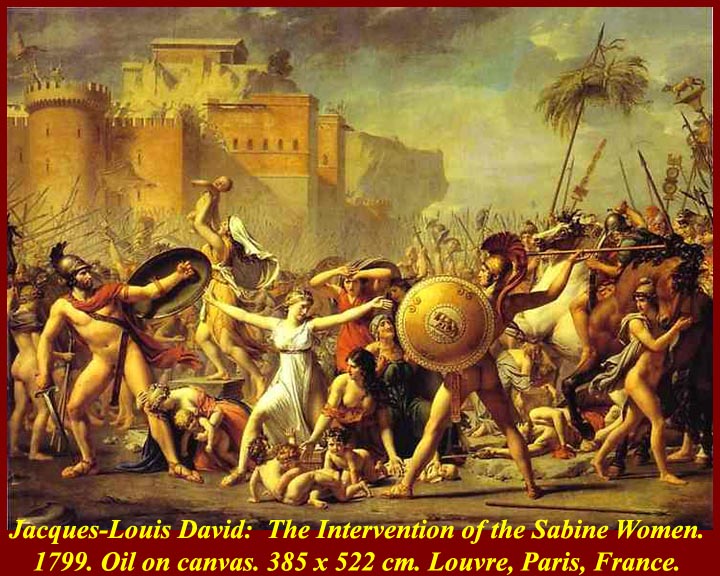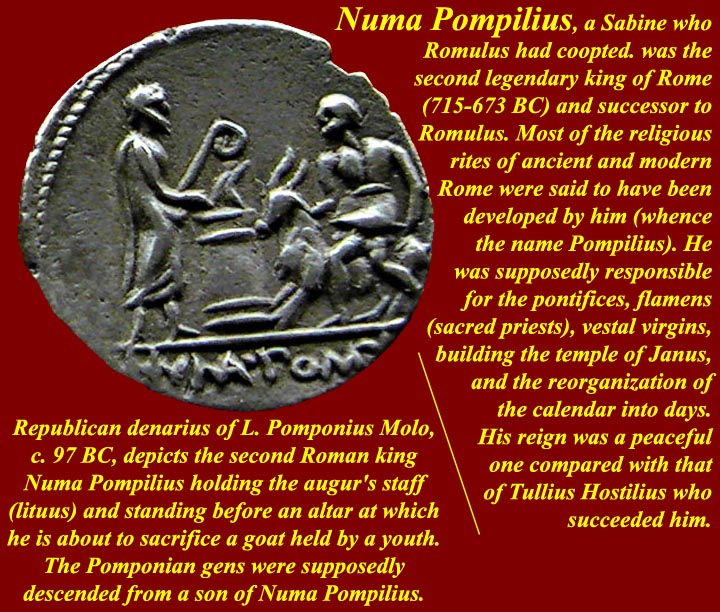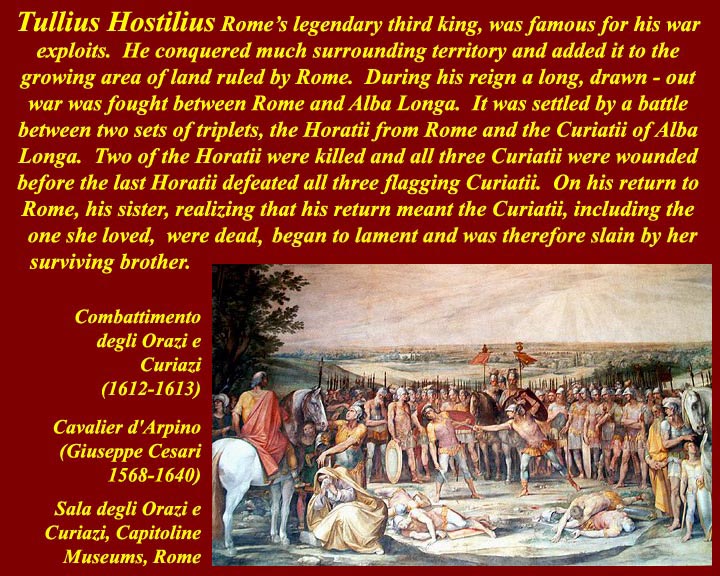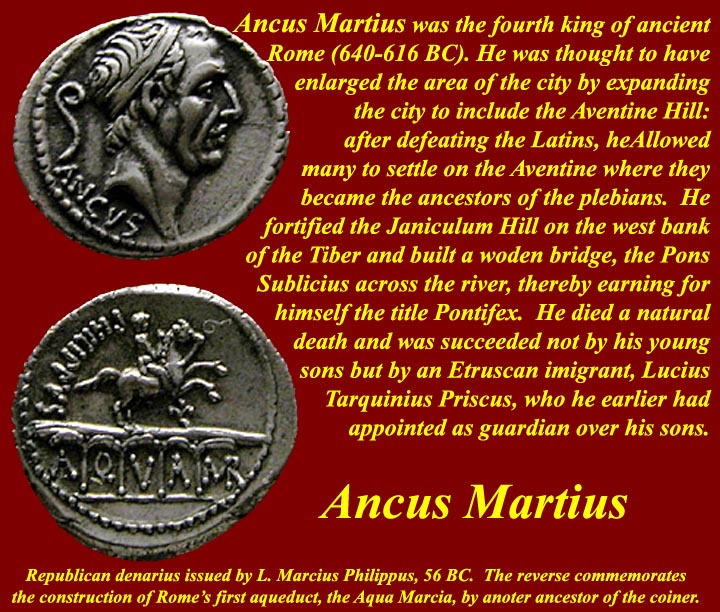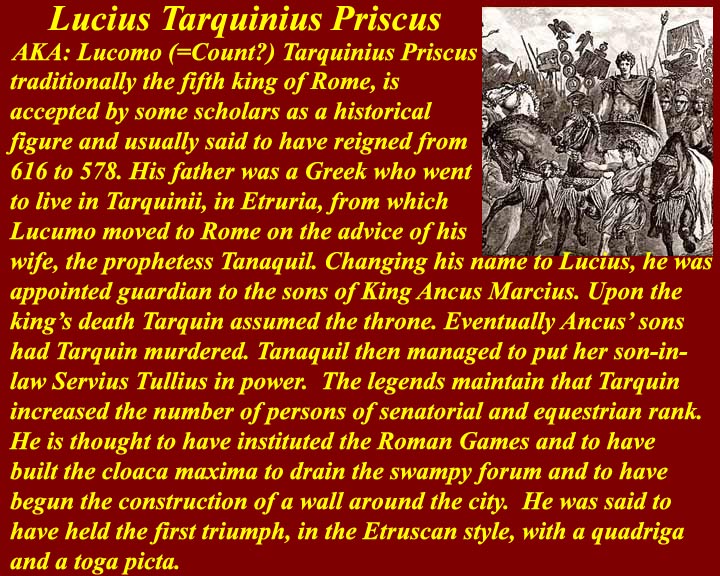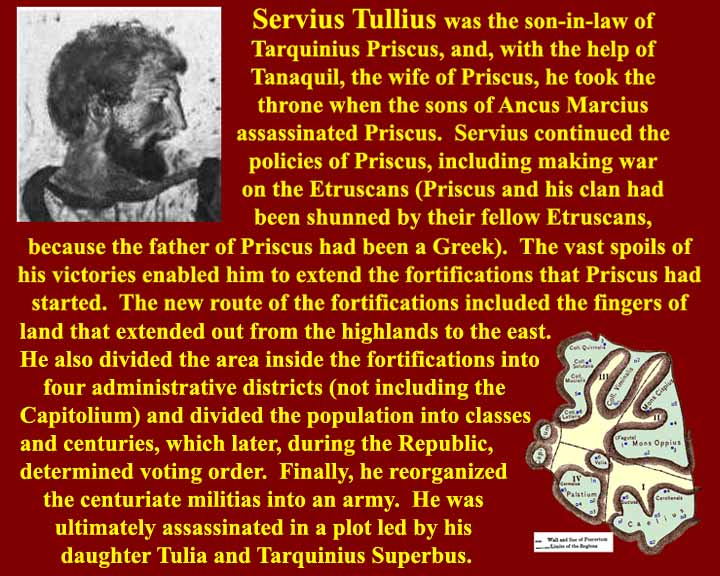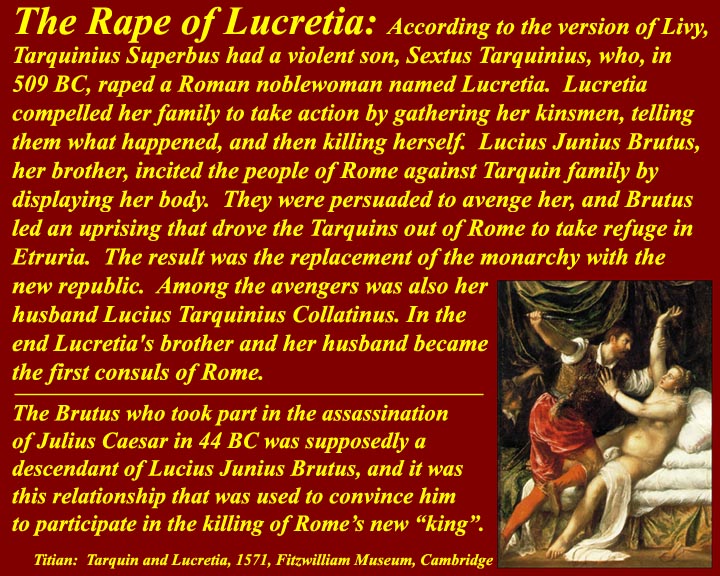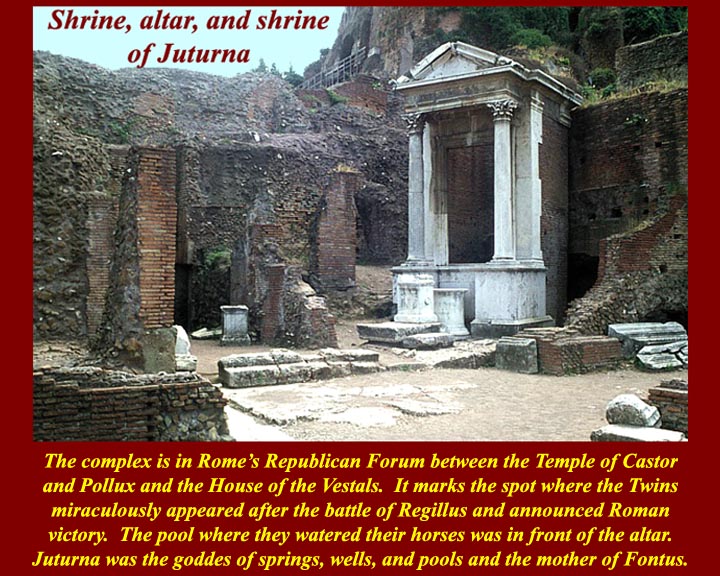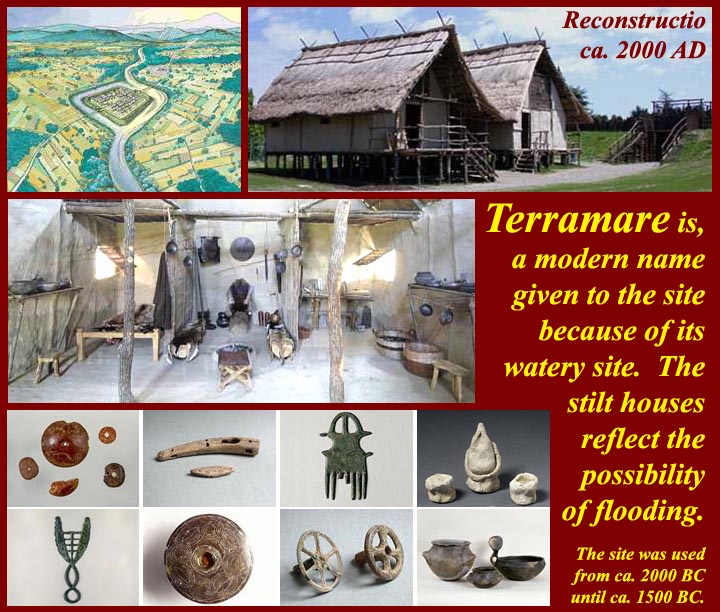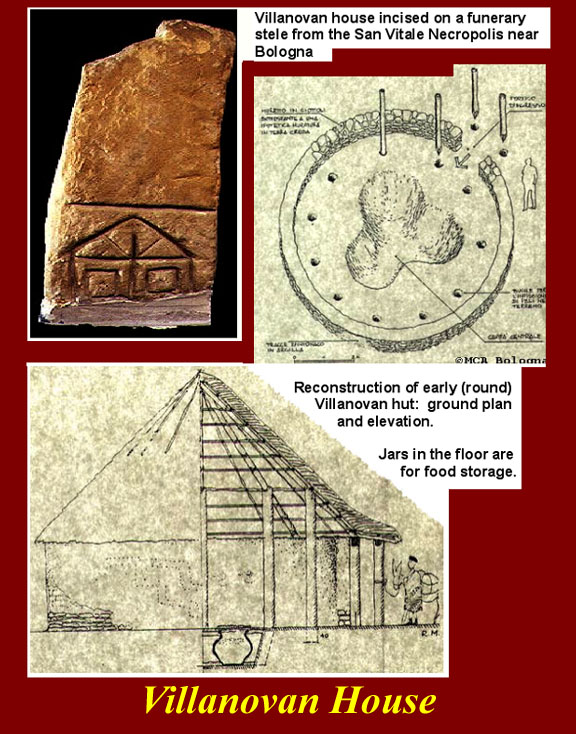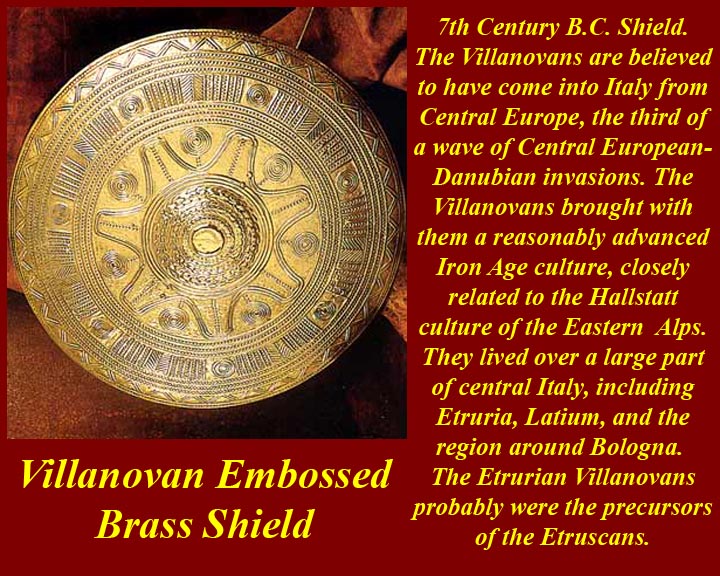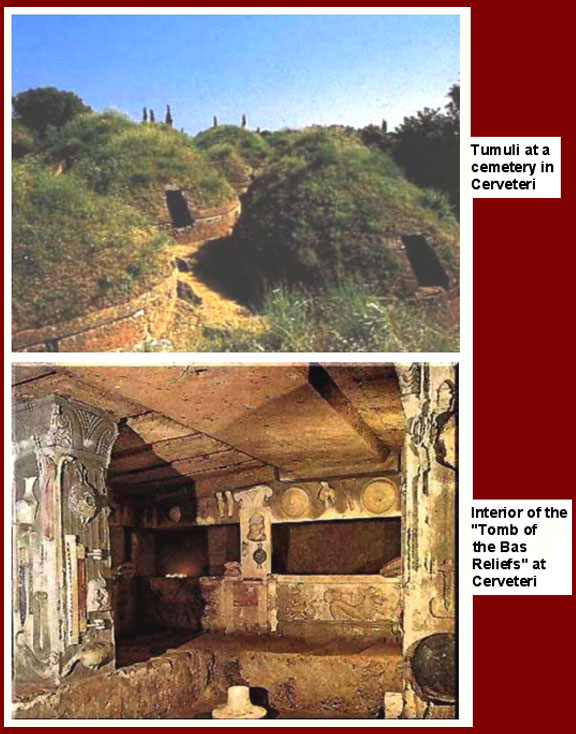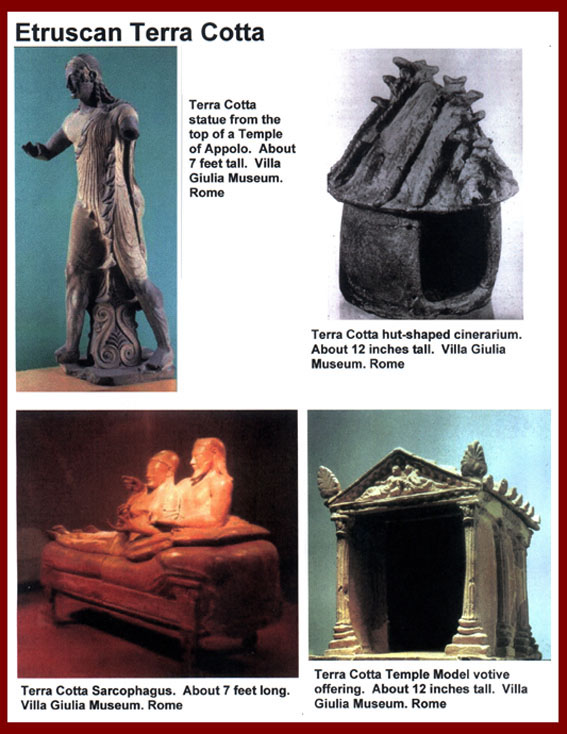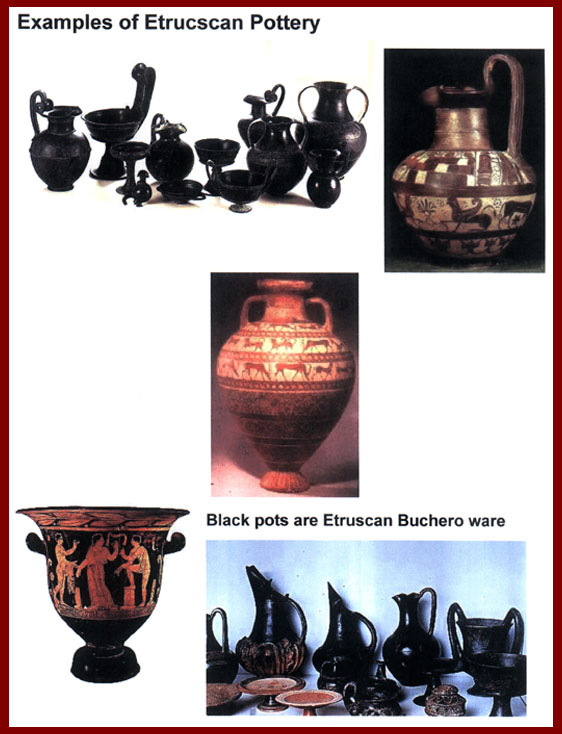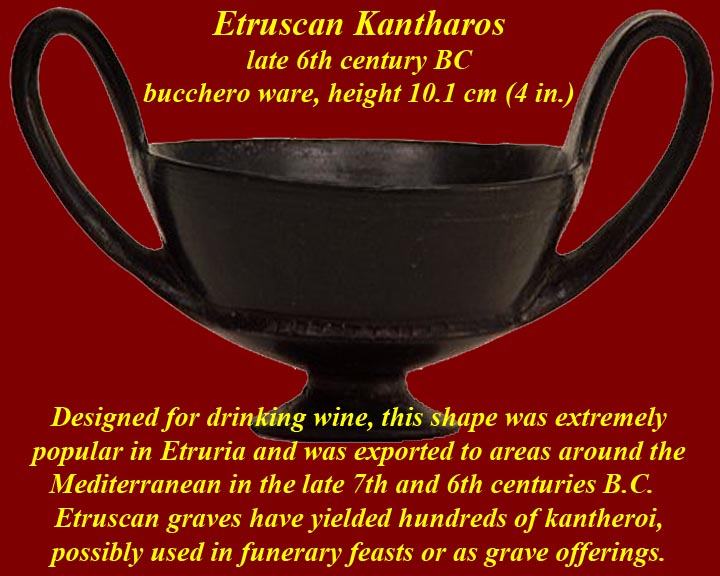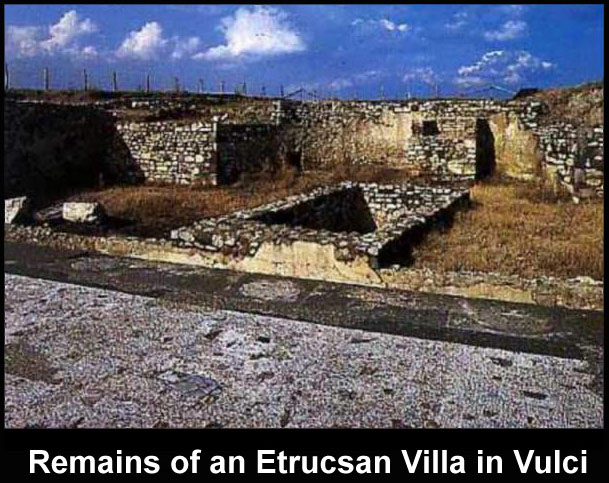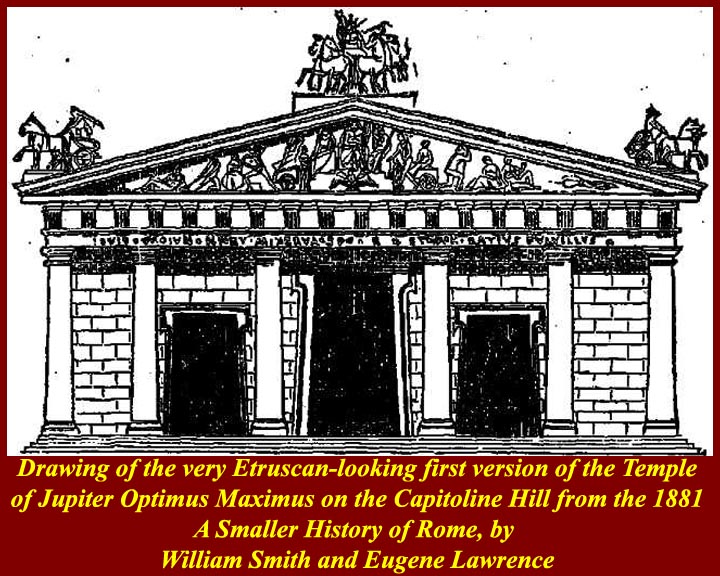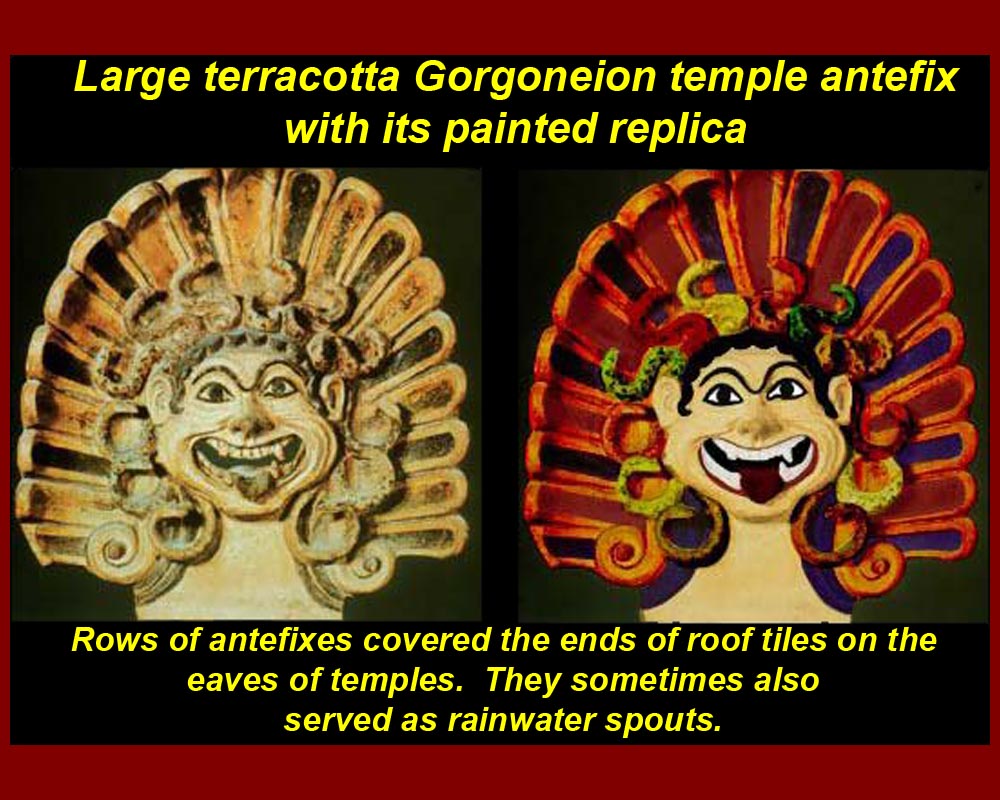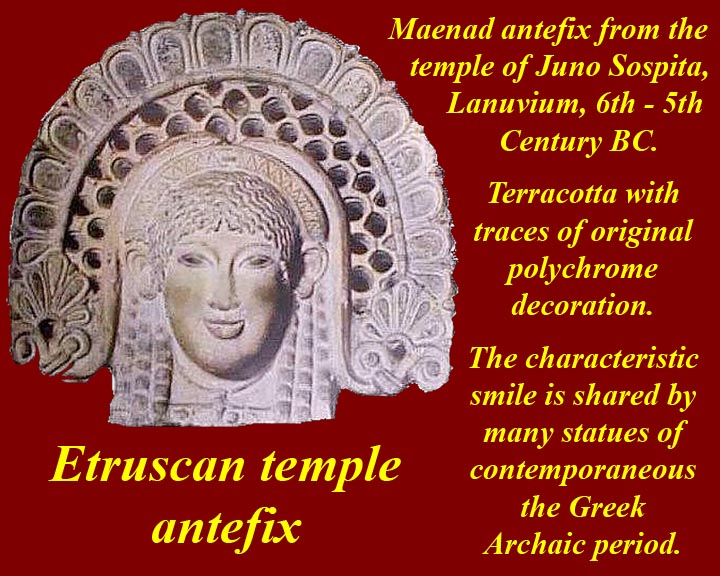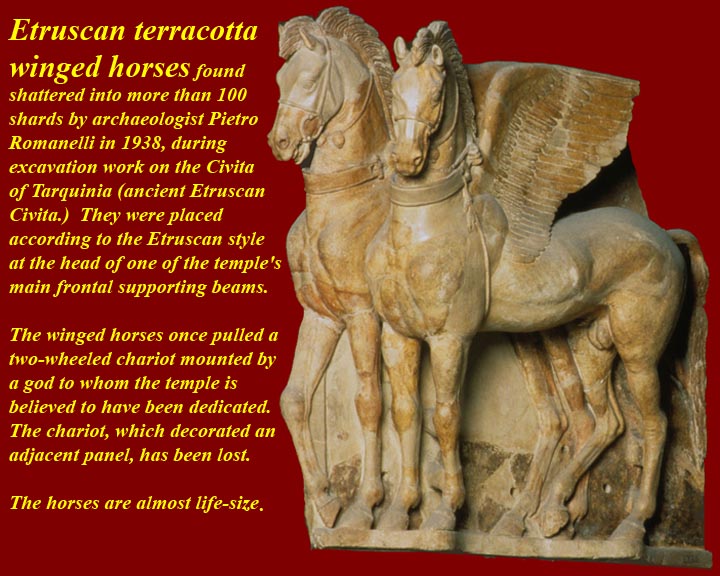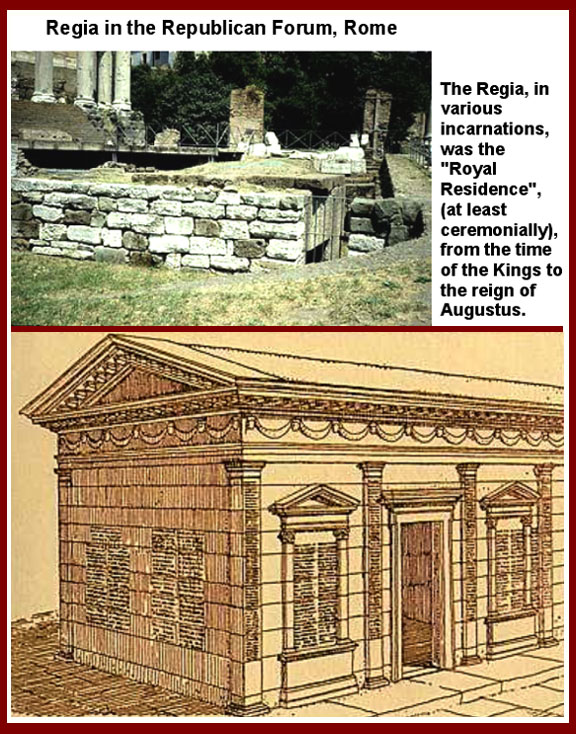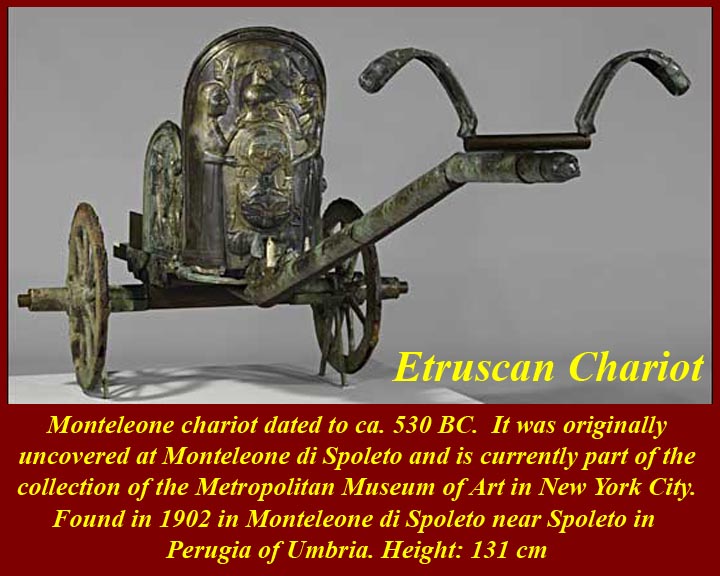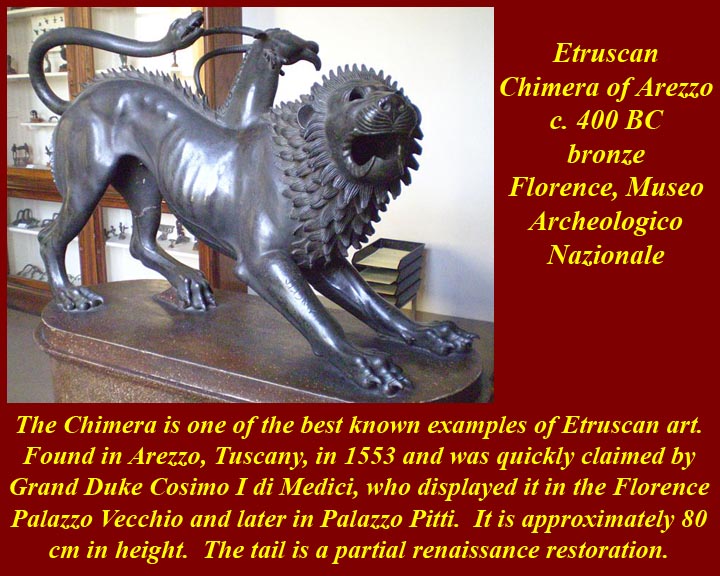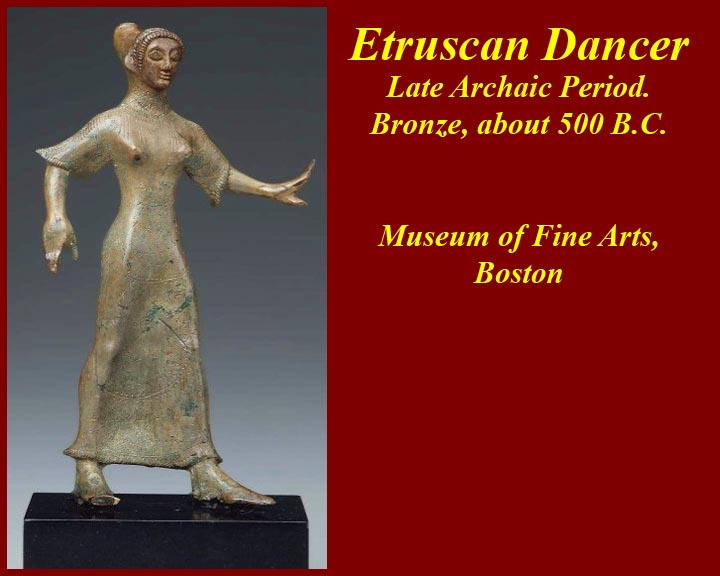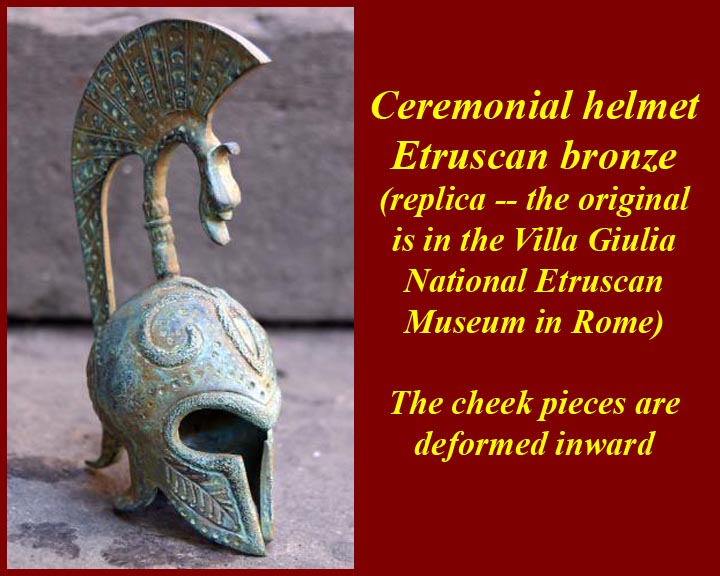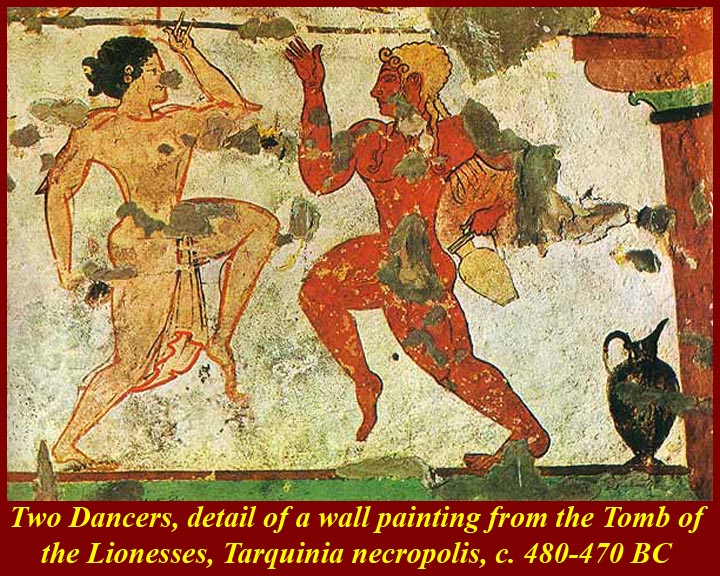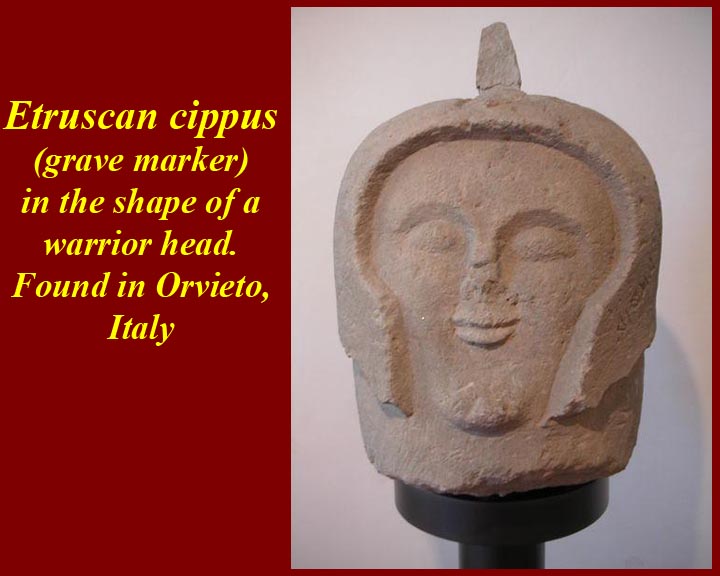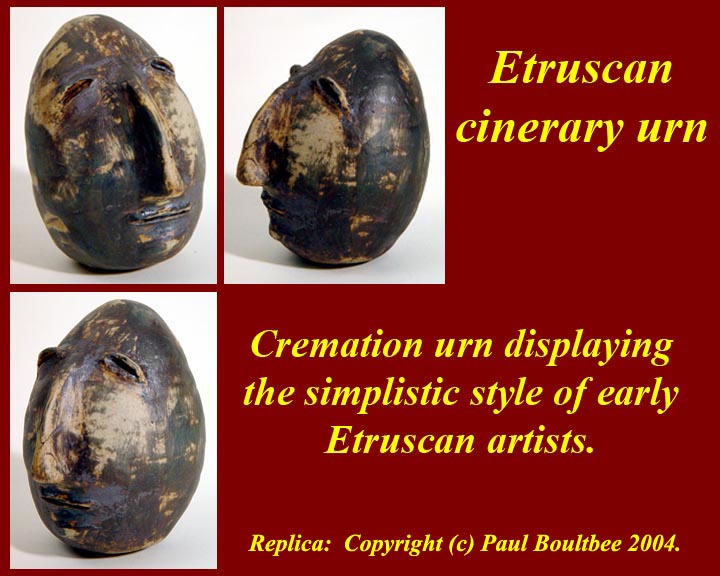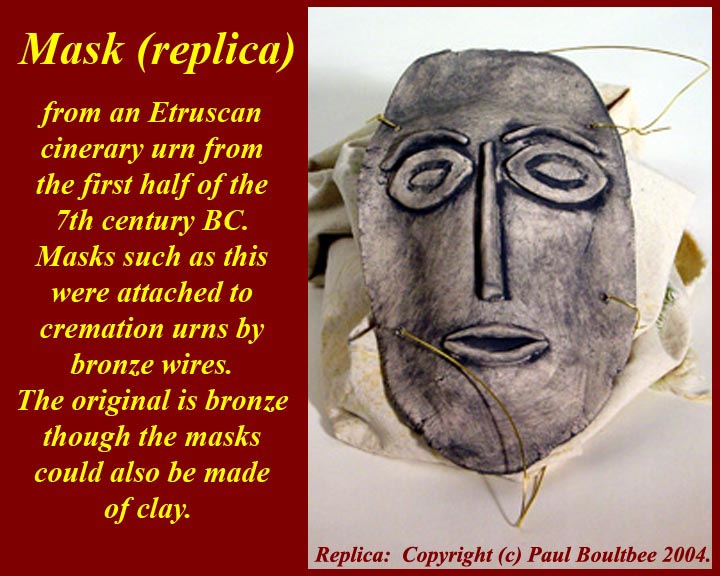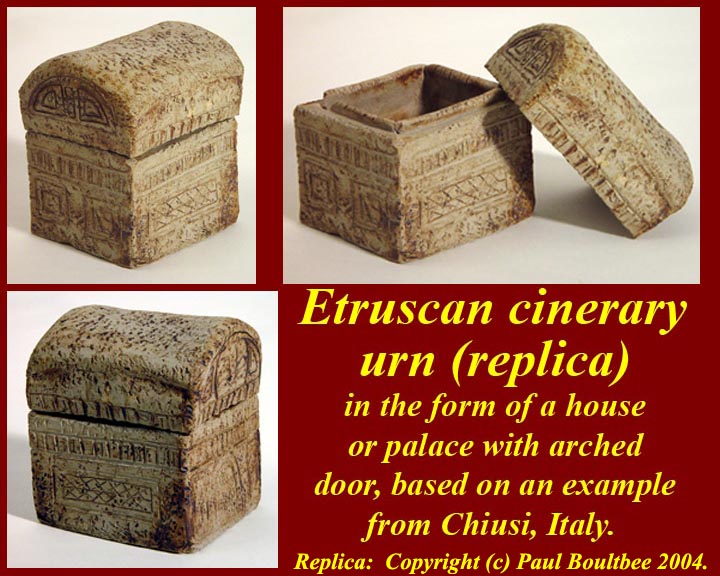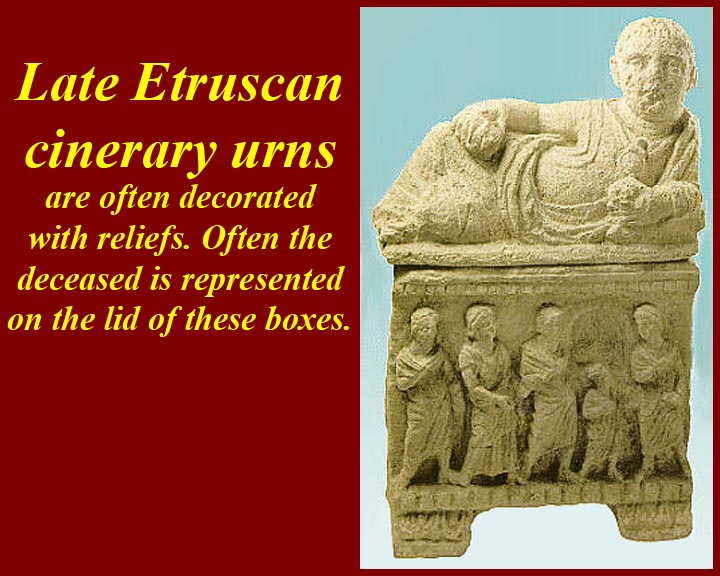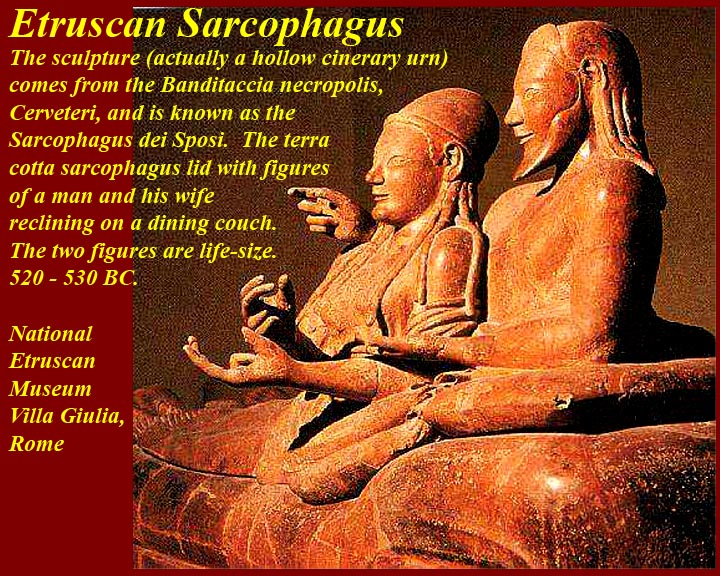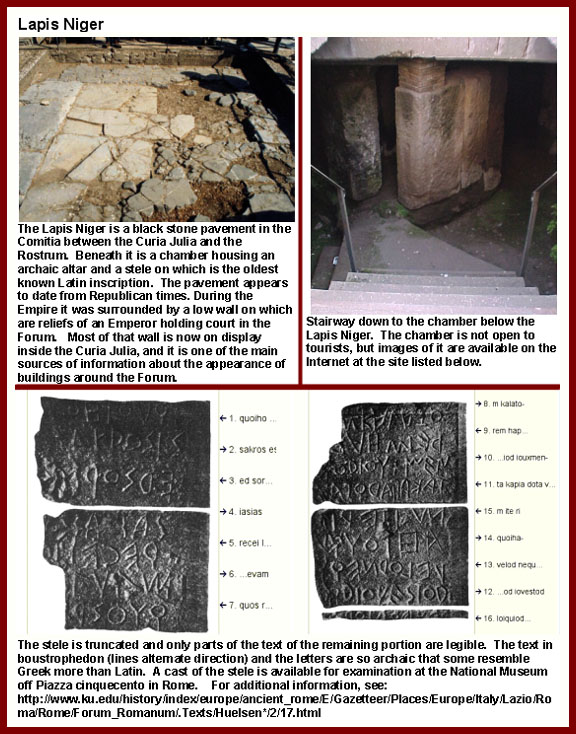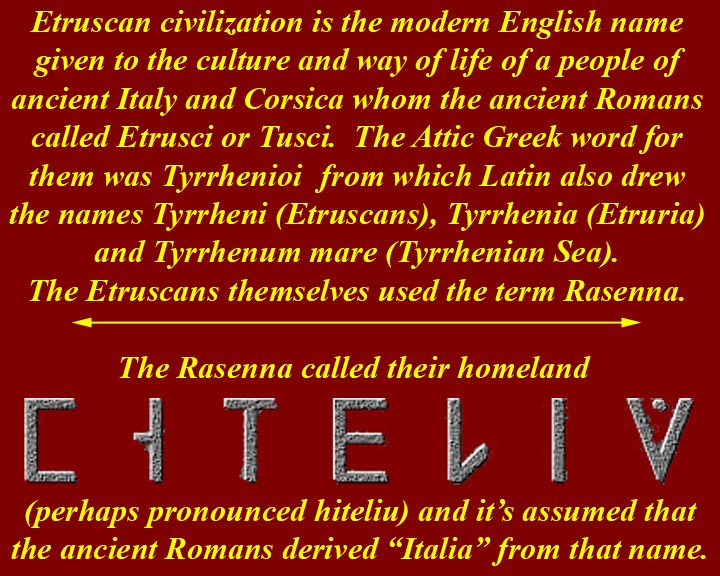Images for ALRI Ancient Rome Unit 2
Approaching Rome
Click on images or image links to enlarge images.
http://www.mmdtkw.org/AU0200aaWolfCartoon.jpg
The ancient Roman founding myth involved the temporary adoption of Romulus and Remus by a wolf.
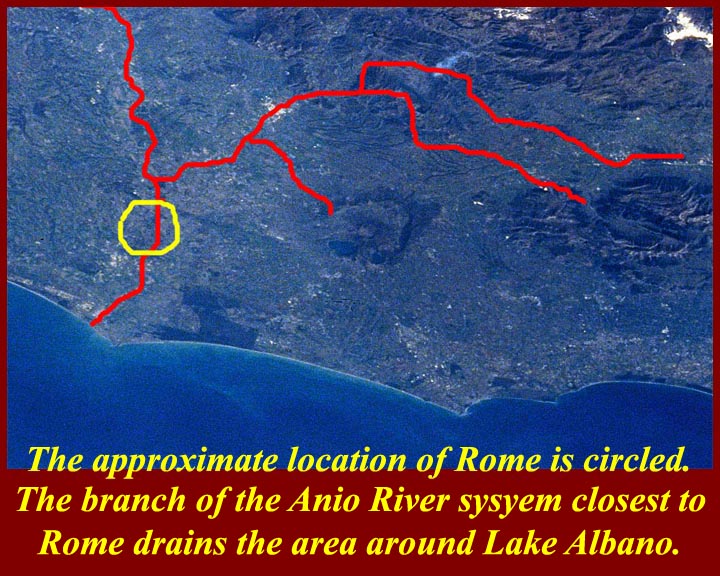
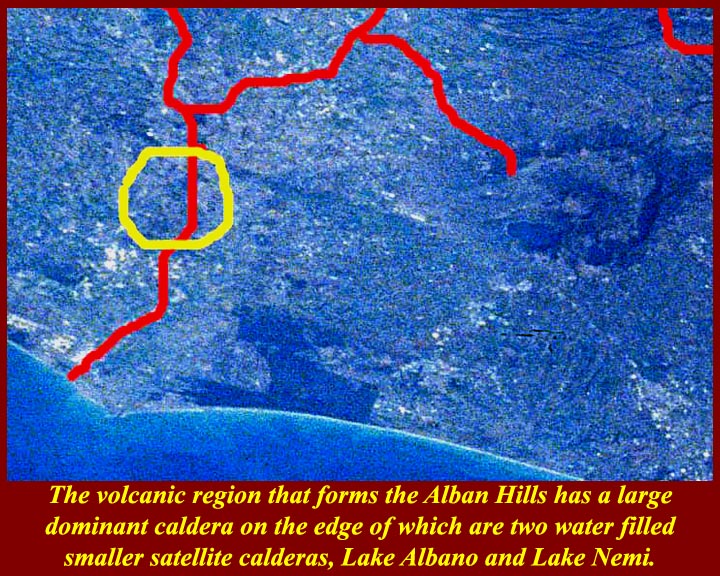
http://www.mmdtkw.org/AU0200bSatellite.jpg
http://www.mmdtkw.org/AU0200cSatellite.jpg
http://www.mmdtkw.org/AU0200dAlbanHills.jpg
Rome lies in the eroded Tiber River valley between two volcanic highlands. The plains above the valley are composed almost entirely of volcanic tuff and are punctuated by extinct composite volcanic calderas. The Caldera to the southeast of Rome is called the Alban Hills, and along the edge of a sub-caldera there was the site of Alba Longa.
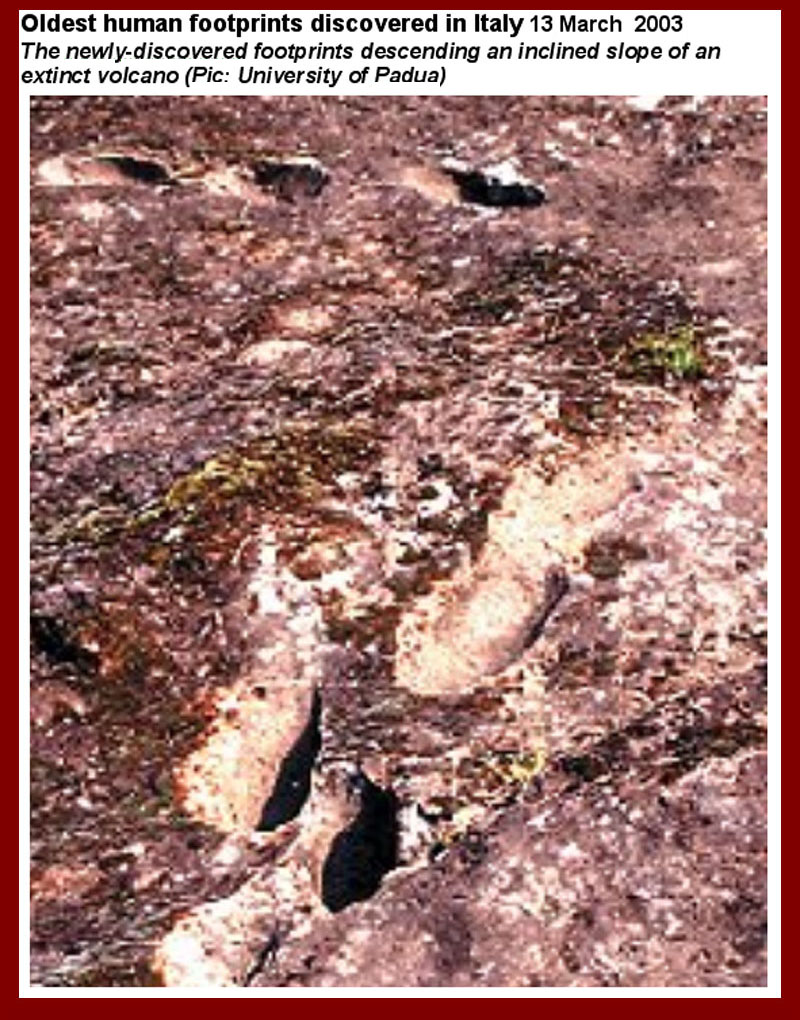
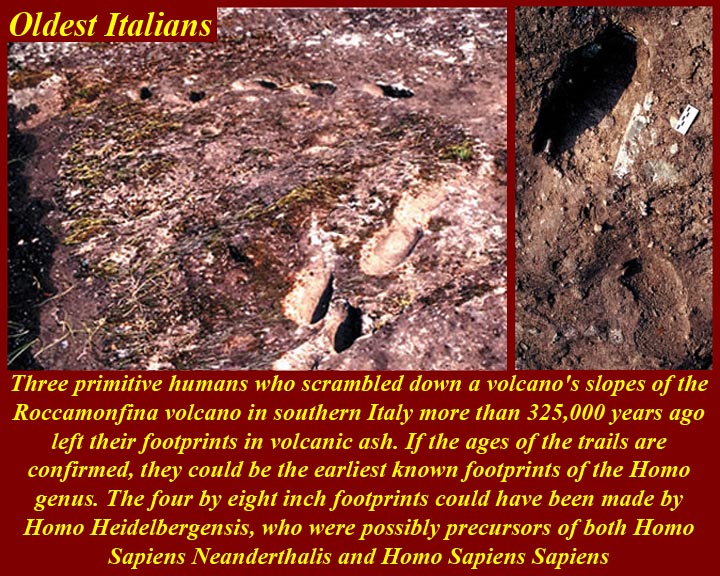
http://www.mmdtkw.org/AU0201aOldestFootprints.jpg
http://www.mmdtkw.org/AU0201bAncientFootprints.jpg
http://www.mmdtkw.org/AU0201cAncientFootprints.jpg
There were people in Italy. The earliest detected human footprints, shown above, are in a layer of datable, hardened volcanic ash (tuff) on the slope of Roccamonfina Volcano at the northern edge of the Campi Flegrei between Naples and Rome. The ash layer dates from about 350,000 BC. It's not known if the prints were made by homo sapiens neanderthalis or by homo sapiens sapiens.
http://www.mmdtkw.org/AU0201ddRomanNeanderthal.jpg
Neanderthals near Rome: the image shows a 100,000 year old female Neanderthal type skull recovered in 1929 from the bank of a small tributary of the Tiber near Rome. A second Neanderthal skull was found in the same area in 1935.
http://www.mmdtkw.org/AU0201dOtzi.jpg
Compared to the folks above, Otzi the Iceman (found in 1991 melting out of the Schnalstal glacier in the Ötztal Alps, near Hauslabjoch on the border between Austria and Italy), is young. He dates from 3500 BC.
http://www.mmdtkw.org/AU0201eeLoversMantua.jpg
The Mantua "lovers", about the same age as Otzi, knocked him out of the headlines. There are other entwined skeletons in Italy -- in places mostly around Vesuvius -- but this is the only known purposeful entwined burial. There is no obvious indication of a cause of their deaths, so there is some speculation that they may both have died as a result of some illness.
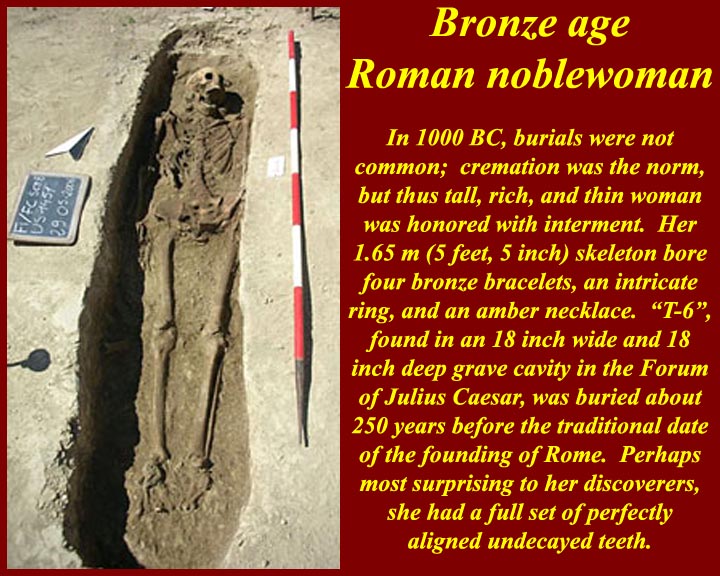
http://www.mmdtkw.org/AU0201eToothyForumWoman.jpg
http://www.mmdtkw.org/AU0201fToothyForumWoman.jpg
Her orthodontist would have been proud. This obviously rich, probably "noble" woman from 1000 BC was discovered in a narrow grave in what later became the Forum of Julius Caesar. Her interment was rare; during that period, most folks were cremated and interred in cinerary urns.The Republican Forum wasn't developed as the commercial, legal, social, and religious center of Rome for another 500 years, 250 years after the foundation of Rome. The Forum of Julius Caesar was started another 500 years later and finished and dedicated in 46 BC. Some experts say that it actually was finished by Caesar Augustus (Octavian) a few years after the death of Julius Caesar.
http://www.mmdtkw.org/AU0201gCineraryBurial1000BC.jpg
This is one of several of the more common cremation burials found in the forecourt of Caesar's Forum.
We'll now pick up the "founding myth" of Rome, as canonized and expounded by Virgil (Aeneid) and Livy (Ab Urbe Condita) in the time of Augustus. (Click Aeneid and Ab Urbe Condita for full English translations.)
http://www.mmdtkw.org/AU0202aFallOfTroy.jpg
Virgil and Livy agree that it all started with Aeneas. He was a Trojan, a son of the goddess Venus, who escaped the general destruction and slaughter at the end of the Trojan War. The reason the Greeks spared Aeneas in murky, but he was allowed to leave Troy with what he could carry: he chose to carry out his father, the Palladium (or perhaps his own household gods), and, according to some sources, his son, Ascanius (A.K.A., Iulus). He left behind his womenfolk -- he was a man of his times, who probably considered them unimportant and replaceable. (The Palladium was an image of Pallas-Athena that was supposed to protect the city of Troy or whoever clung to it. The legends say that it protected neither the city nor Cassandra -- see the image above.)
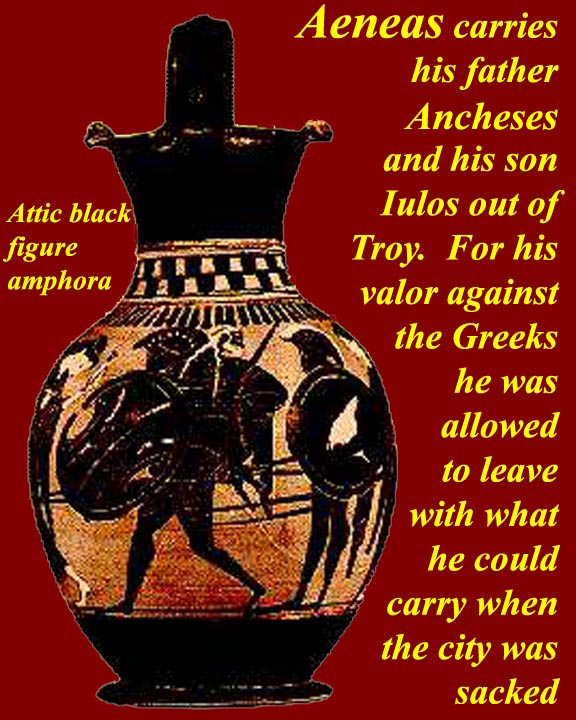
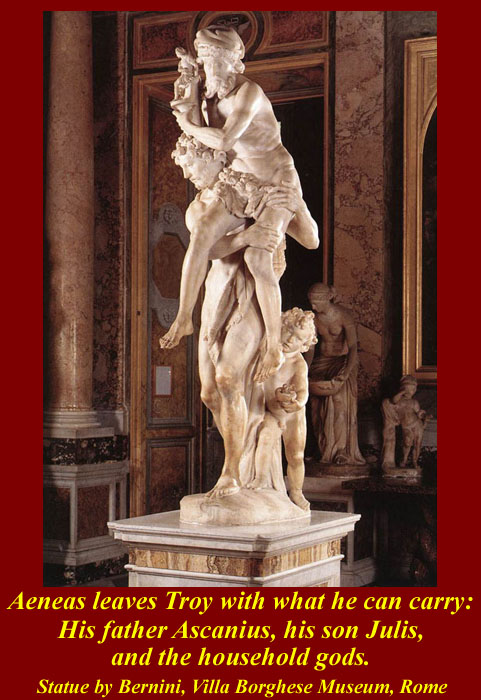
http://www.mmdtkw.org/AU0202bAeneasLeavesTroy.jpg
http://www.mmdtkw.org/AU0202cBerniniAeneas.jpg
http://www.mmdtkw.org/AU0202dAeneas.jpg
After leaving Troy Aeneas picked up a crew and started his voyages and adventures around the Mediterranean. The route he took, as derived from legends is fairly well worked out in the Aeneid and shown on the map above. One of his more important stops, before reaching Latium where his son founded Alba Longa and his descendants founded Rome, was an interlude with Dido in Carthage, which she had recently founded. More on that later.
http://www.mmdtkw.org/AU0202eJCaesarDenarius.jpg
Julius Caesar, Augustus, and the rest of the Julio-Claudian imperial dynasty claimed to be descended from Iulus, the son of Aeneas. This meant, of course that they were also descended directly from Venus. In a bit, we'll see how Mars also got into the Julian line. It can be argued that the whole purpose of Virgil's Aeneid was to glorify the heritage of Julius Caesar and of Virgil's patron, Augustus.
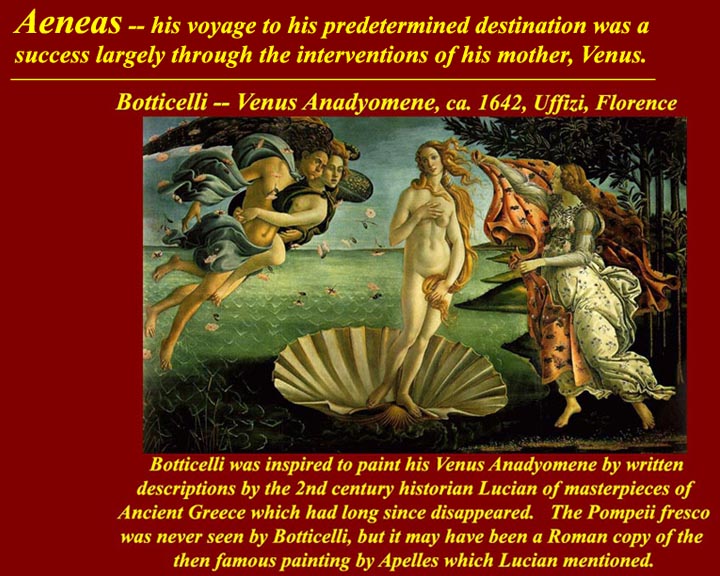
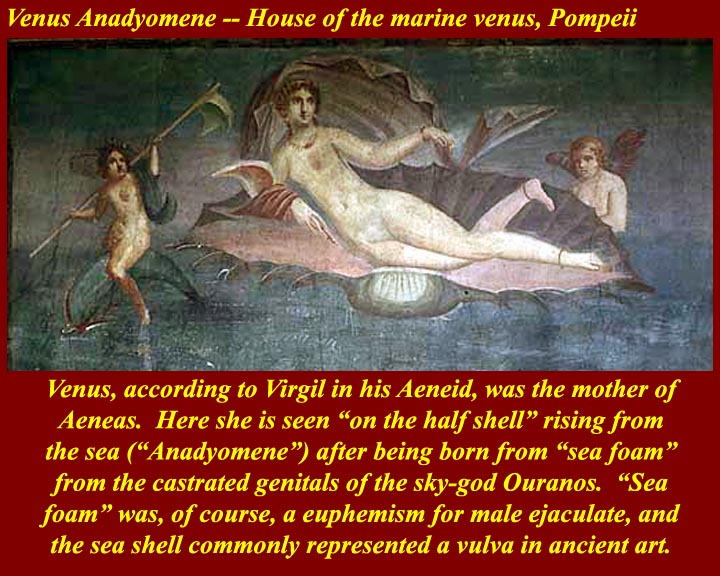
http://www.mmdtkw.org/AU0202fBotticelliVenusUffizi.jpg
http://www.mmdtkw.org/AU0202gVenusAnadyomenePompeii.jpg
Just as a reminder of where the Roman goddess Venus came from: She was originally the Roman goddess of springtime but then was identified with and acquired the attributes of the Greek goddess Aphrodite. Aphrodite's birth was unusual: she rose from the foam after the severed genitals of the pre-Olympian god Ouranos were thrown into the sea. In ancient folk etymology, Aphrodite's name was said to be derived from "aphros" = "foam". Ouranos was translated into Latin as Uranus, but the name of the Roman god that was the equivalent of Ouranos was Caelus, the sky. Ouranos (Caelus) was the spouse of Gaia (Terra).
http://www.mmdtkw.org/AU0202hAeneasDidoMosaic4.jpg
Dido and Aeneas: Dido was said to have been a Phoenician princess from Tyre who fled from the tyranny established in Tyre after her brother, Pygmalion king of Tyre, murdered her husband, the high priest. She founded Carthage and its Punic (i.e., Phoenician) dominions. Shortly after founding Carthage (its name came from the Phoenician Kart-Hadasht, “New City”) she was visited by Aeneas. He stayed on long enough for her to have a child, and then abandoned her after Venus sent her messenger Mercury to remind him that his destiny was in Latium, not in North Africa. Dido immolates herself, but her son founds the first Carthaginian dynasty -- and from there stems the long and fatal rivalry between the offspring of Aeneas in Carthage with his offspring in Rome. (This is all, of course, the Roman version of the myth. The Carthaginian version is only available in Roman glosses.)
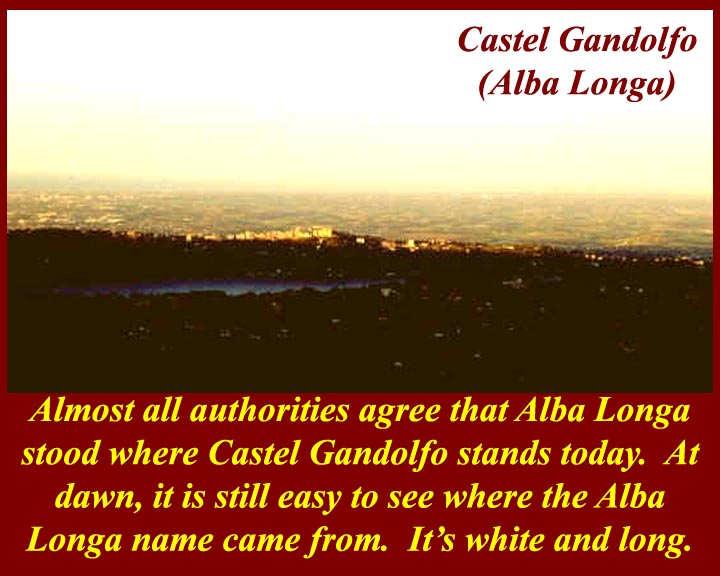
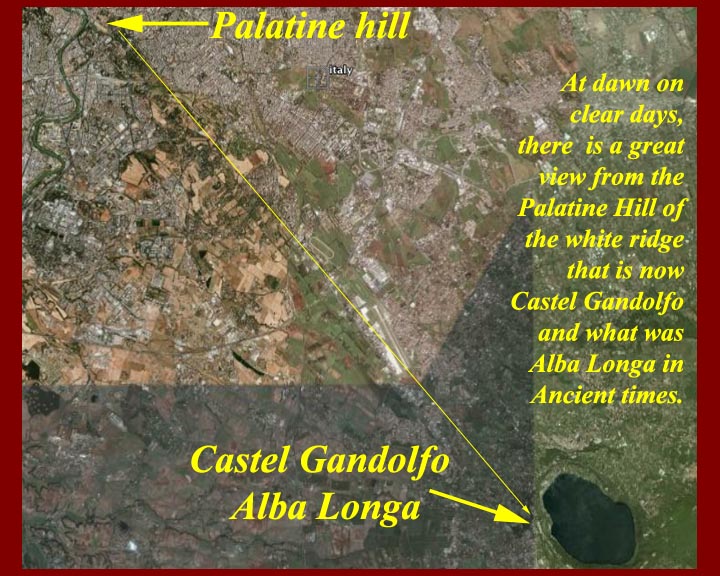
http://www.mmdtkw.org/AU0202iAlbaLonga.jpg
http://www.mmdtkw.org/AU0202JAlbaLongaView.jpg
http://www.mmdtkw.org/AU0202kModern.jpg
Aeneas headed for Italy and, after at least one stop in the south, landed in Latium near Anzio. There he found an ancient temple of Hercules where he went to pray. When he approached the temple he saw that his old enemy Ulysses (Odysseus) was already inside. To avoid recognition, Aeneas covers his head with his cloak before entering the temple, thereby starting the Roman tradition of praying with a cloak or the edge of a toga over the head. After leaving the temple, Aeneas meets with a local Latin chieftain and either fights him for his wife (or daughter), or is given the daughter by agreement. (The legends are confused, according to Livy.) It may also be here that Ascanius/Iulus is born, rather than before leaving Troy. At any rate, the city of Lavinium (named after the bride, Lavinia) is founded, and shortly thereafter, the Latin city of Alba Longa is founded.
The location of Alba Longa is almost certainly where the Papal summer retreat, Castel Gandolfo, stands today. At dawn on clear days, one can still see the "long white thing", i.e., "Alba Longa" from Rome's Palatine Hill if you know where to stand and which way to look -- you need to stand on the edge of the Palatine overlooking the Circus Maximus. Face the Circus, and then turn your head 90 degrees to the left and look for a white streak on the horizon. That's Alba Longa. The traditional ancient Roman place to sight Alba Longa was the Arx, the higher of the two peaks on the Capitoline Hill, but that view has been blocked since the Renaissance.
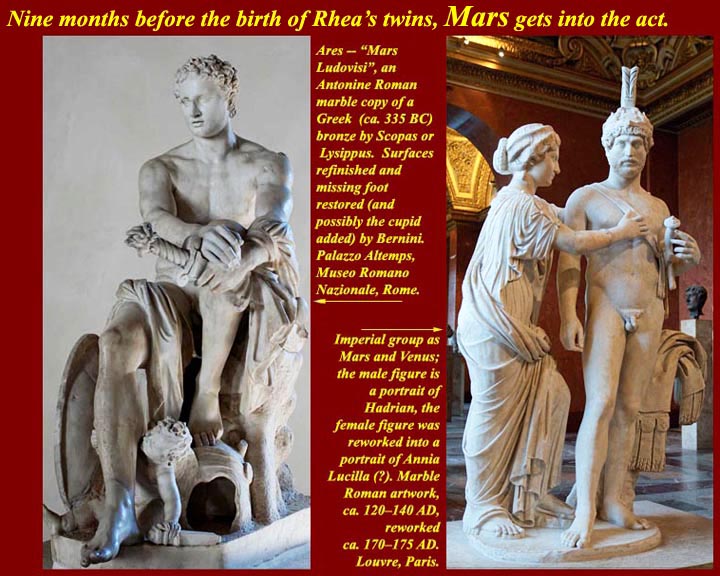
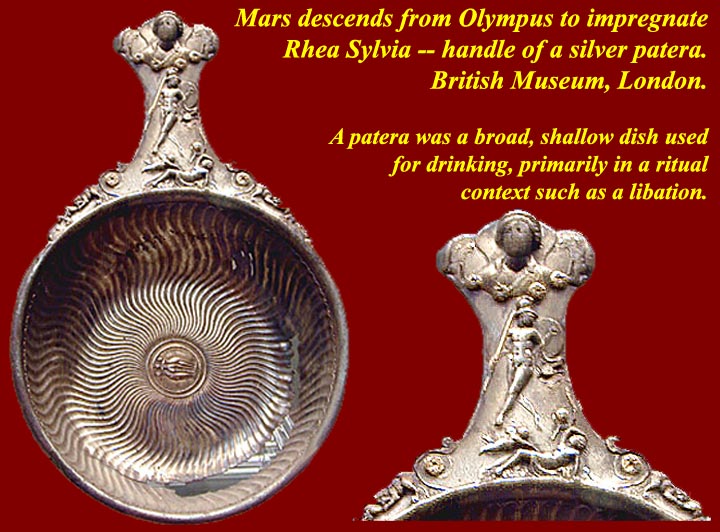
http://www.mmdtkw.org/AU0202LMars-MarsVenus.jpg
http://www.mmdtkw.org/AU0202mMarsRheaPatera.jpg
http://www.mmdtkw.org/AU0202nRheaSylvia.jpg
Mars: It was in Alba Longa, centuries after it was founded that Mars came into the picture. The royal family had produced twin sons named Numitor and Amulius. Numitor was a few minutes older and inherited the throne. His evil brother Amulius overthrew Numitor, imprisoned him, and ordered the death of all of Numitor's progeny excepting only a young daughter named Rhea Sylvia. He sent her to be a priestess (anachronously, a "Vestal virgin") to prevent her from producing heirs in Numitor's line. The inevitable happened: she was visited in her nunnery by Mars, who raped her -- her story and she's stickin' to it. She produced another set of twins, Romulus and Remus. Her uncle Amulius ordered her and the kids thrown into the swamp. She was rescued by the river god Tiberinus and the two boys floated down the Anio River, into the Tiber, and washed ashore at the base of the Palatine Hill.
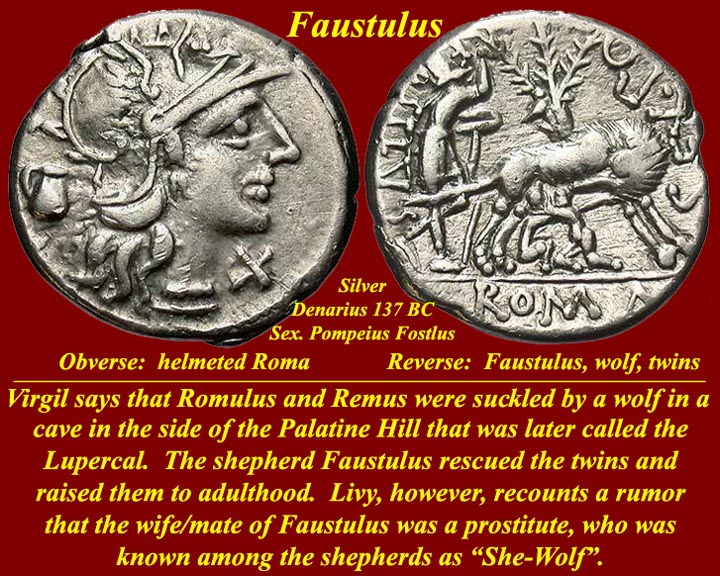
http://www.mmdtkw.org/AU0202oFaustulus.jpg
http://www.mmdtkw.org/AU0202plupercal-1.jpg
Romulus and Remus were suckled by a wolf in a cave at the base of the Palatine before being taken away and raised by a shepherd named Faustulus. Alternatively, they were found on the riverbank by Faustulus and raised by him and his wife, Acca Laurentia, who was a notorious whore called Lupa. Whether wolf (lupa) or whore (Lupa), the boys grew up to found Rome.
But first they had other business. According to legend, Remus was taken prisoner in a local war and hauled before Amulius in Alba Longa. Romulus rescued him, and in the battle Amulius was killed and Numitor was freed from his imprisonment. Somewhere along the line, the true identity of Romulus and Remus as the grandchildren of Numitor was revealed. Out of piety (i.e., filial responsibility) the twins -- princes now -- left Alba Longa in the hands of their grandfather and went back to their Tiber river-front property to found their own city. After some augury Romulus claimed the right to set sacred boundaries on the Palatine hill. (Augury is divination based on the the activity of birds: the "au" in augury is based on the Latin word "avis" which meant "bird", the "u" and "v" being used interchangeably. "Augury" would originally have been something like "avi-gury". In later Roman use an "augur" was a practitioner of any type of divination.)
Romulus, according to legend, killed Remus, who had committed sacrilege by crossing the line of the pomerium, the sacred boundary, without using a legal gate (but this could well be a euphemism for invading the city). For more on all this, see http://www.mmdtkw.org/VFoundMyths.html or for much greater detail, Livy (Ab Urbe Condita), http://www.forumromanum.org/literature/liviusx.html.
The reigns of the individual kings are unrealistically long, especially considering that average life expectancy for the period was under 30 years. Some historians suggest that each King" may actually represent several kings with similar names. Others say that the whole assemblage of kings is just a later myth and so we shouldn't worry about temporal inconsistencies..
Traditional dates of the Roman Kings Also see https://en.wikipedia.org/wiki/King_of_Rome
ROMULUS (REMUS) (753-715 BC)
NUMA POMPILIUS
(715-673 BC)
TULLIUS HOSITILIUS
(673- 642 BC)
ANCUS MARCIUS
(642- 617 BC)
LUCIUS (LAUCHMO) TARQUINIUS PRISCUS
(617- 579 BC)
SERVIUS TULLIUS
(579- 535 BC)
LUCIUS TARQUINIUS SUPERBUS
(534- 510 BC)
The Kings:
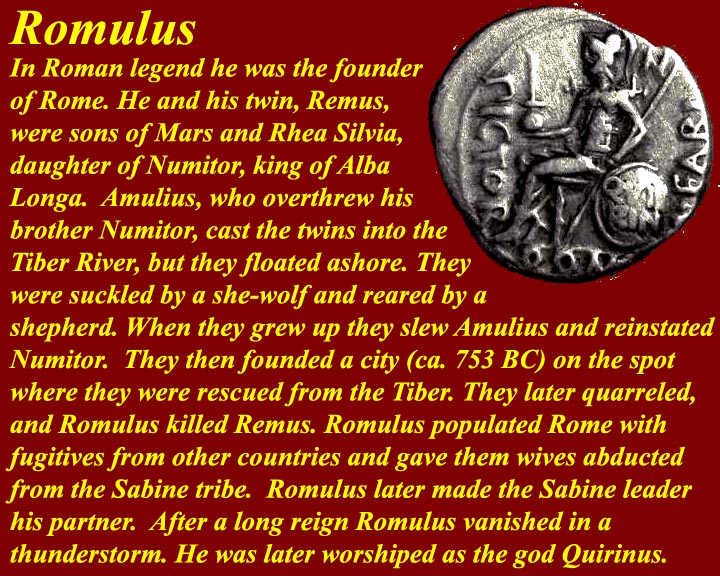
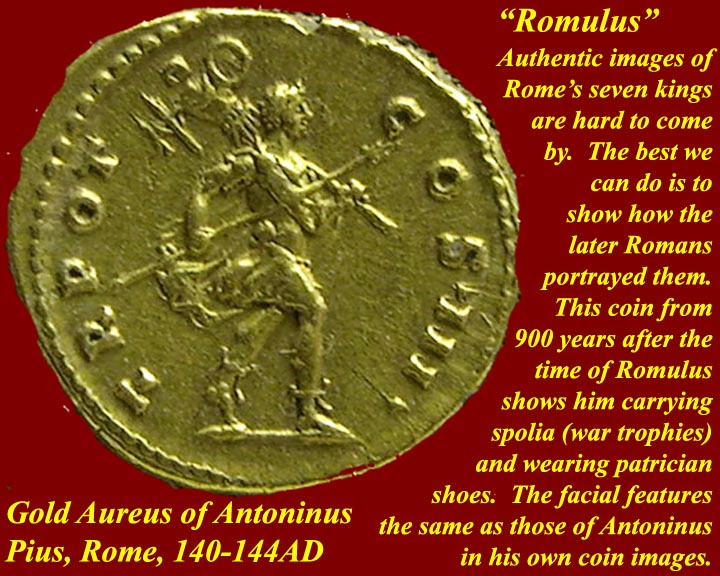
http://www.mmdtkw.org/AU0203aKings1aRomulusQuirinus.jpg
http://www.mmdtkw.org/AU0203bKings1bRomulus.jpg
After eliminating the competition (by killing Remus) Romulus became the sole ruler and first "King" of Rome. It was a very primitive assemblage that he ruled over, and the king title certainly applied only to the tiny settlement that he ran on the Palatine hill and perhaps to the adjacent Capitoline hill. Romulus didn't have much population to rule over, so he advertised for recruits, and the recruits he attracted were criminals and outcasts -- he and Remus were of the same ilk. According to legend it was at this time that the pattern developed of first housing new recruits in "asylum", the saddle between the two peaks of the Capitoline, where they had to stay until it was clear they would make acceptable neighbors on the Palatine. Settlements by members of other groups, the Sabines, Latins, and probably Etruscans were on nearby hills (the Etruscans on the other side of the Tiber) and there was some trade and intercourse in the swampy area that 250 years later became the Roman forums. The swamp also was used, as seen above, as a cemetery.
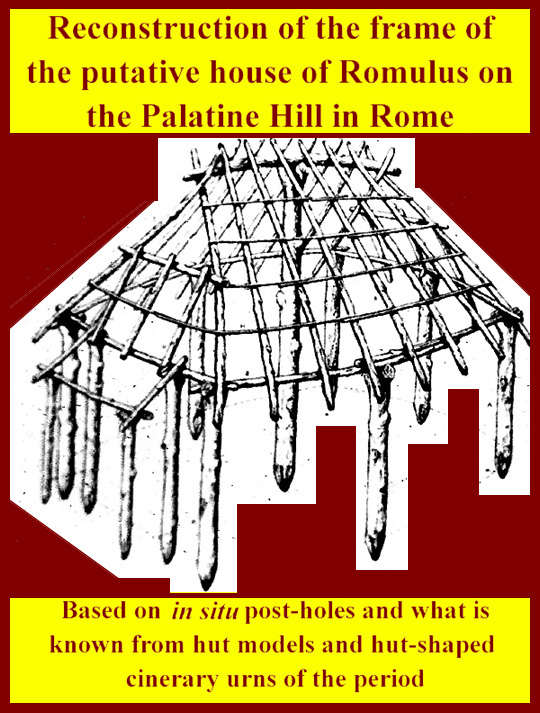
http://www.mmdtkw.org/AU0210CasaRomuli.jpg
http://www.mmdtkw.org/AU0211RomHutVillage.jpg
The settlement on the Palatine dating from the supposed time of Romulus is sometimes called "Roma quadrata", which doesn't mean "Rome square shaped" but, rather, "Rome enclosed in boundaries" (quadrata could also mean "framed", like a picture). The boundaries were, according to legend, defined by Romulus himself. Romulus was said to have harnessed a cow and a bull of snow-white color to a plough whose share was made of brass. Romulus ploughed "a furrow along the line of the future walls. He took care that the earth of the furrow should fall inward towards the city, and also to lift the plough and carry it over the places where gates were to be made." (Quotation from http://www.mainlesson.com/display.php?author=morris&book=roman&story=founded)
Romulus's followers improved the furrow ("fosse") and the pile of earth thrown inward by the plough ("agger") to make better fortifications.
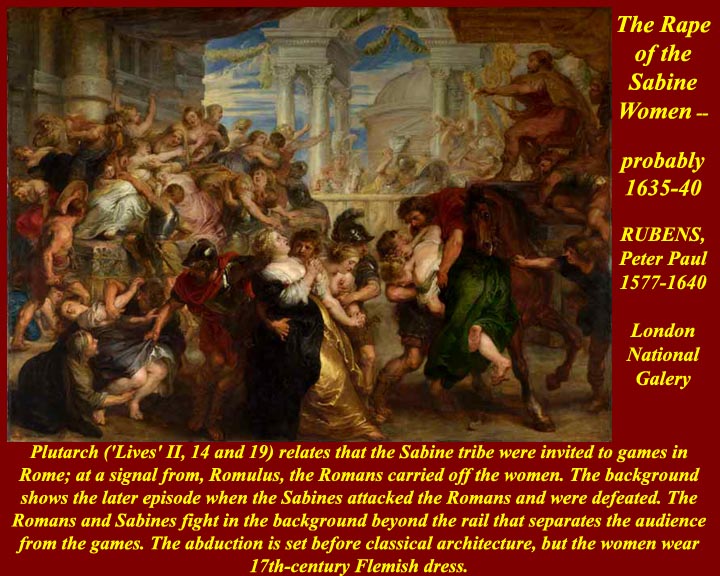
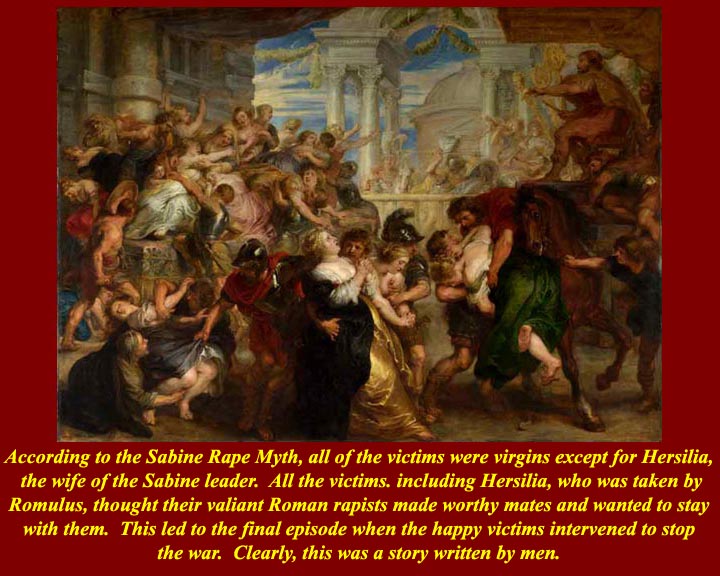
http://www.mmdtkw.org/AU0203cKings1cSabineRape.jpg
http://www.mmdtkw.org/AU0203dKings1dWillingVictims.jpg
The band of outcasts and outlaws on the Palatine raised a few crops, kept a few animals, and apparently stole whatever else they needed -- it was the common pattern of the times (except in the more civilized Etruscan towns.) In the spirit of the times, they also stole their women, and thus the legend of the Sabine Women. They Invited all the Sabines to a party, got the Sabine men drunk, and stole their virgin daughters. They quickly deflowered their victims, who apparently liked this kind of treatment; when the Sabine men sobered up and attacked Rome, the new Roman "wives" intervened to stop the battle between their kinsmen and their new "husbands". A holdover of this respect for this wedding tradition is the fact that all formal roman weddings began with the ceremonial kidnapping of the bride from her family home by the men of the family of the groom.
http://www.mmdtkw.org/AU0203eKings1eTarpeia.jpg
Somewhere in the course of the Sabine attack (or in other versions during another Sabine attack), Tarpeia, a Roman woman (one of the new girls?), showed the Sabines a secret entrance to the city. She hoped to receive as a reward "what the Sabines wore on their left arms". She was thinking of gold bracelets, but the Sabines, instead, crushed her with their shields, which they also wore on their left arms. Her body was thrown off the Capitoline cliff above the Velabrum (between the Capitoline and Palatine hills). Thereafter that cliff was known as the Tarpeian Rock
http://www.mmdtkw.org/AU0203fKings1fSabineWomenIntervene.jpg
Sabine women telling their brothers and their new husbands not to fight.
http://www.mmdtkw.org/AU0203gKings2Numa.jpg
Second King a Sabine: The successor of Romulus as leader "king" of the bandit kingdom was, according to the legend, Numa, the leader of those attacking Sabines. He had headed the pleas of the Roman "wives" and made peace with Romulus, and, for a while, he and Romulus ruled together. Eventually Romulus died (disappeared during a thunderstorm -- maybe standing too close to a lightning rod?) and Numa ruled in his own right. He was called Pompilius because he was said to have initiated most of Rome's traditional priesthoods and religious rites ("pompa" in Latin).
http://www.mmdtkw.org/AU0203hKings3Tullius Hostilius.jpg
Tullius Hostilius, Rome's third legendary king was, indeed, hostile. It was he who brought the ancestral town, Alba Longa, under direct Roman control, and he also added other nearby areas to the Roman sphere. The story of the champions' battle of the the three Roman Horatius brothers against the three Alba Longan Curiatus brothers is shown in the image.
http://www.mmdtkw.org/AU0203iKings4AncusMartius.jpg
Ancus Martius -- Ancus "infused with the spirit of Mars" -- conquered the the rest of the Latin tribes south and east of Rome, and allowed those who so desired to settle on the Aventine Hill, which during his time was included in expanded town fortifications. The Aventine settlers were said to be the origin of the plebeian class in Rome (as opposed to the Patricians, i.e., the "fathers/founders" of the city). It's not clear that the sacred boundary, the pomerium, was expanded at the same time as the fortifications.
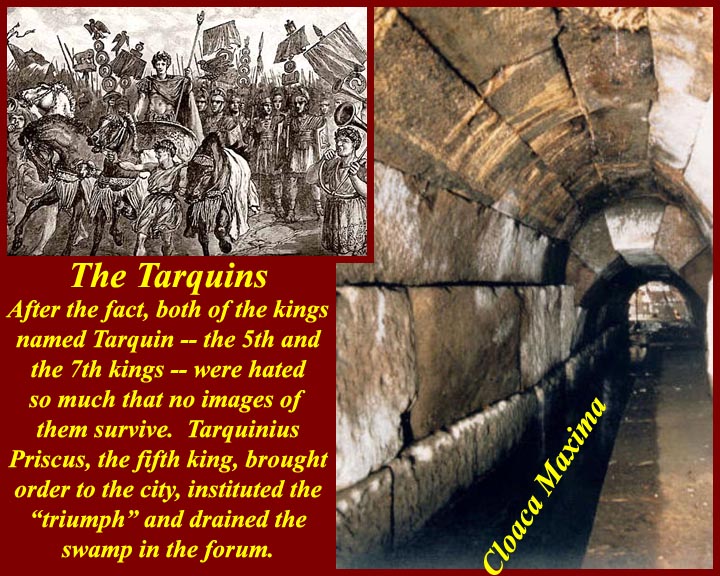
http://www.mmdtkw.org/AU0203jKings5aTarquins.jpg
http://www.mmdtkw.org/AU0203kKings5bTarquinusPriscustriumph2.jpg
At this point in the monarchical register we reach the point where more historians (maybe even most) think we might be dealing with real people -- but with one important caveat.
Lucius Tarquinius Priscus and his wife, the priestess/prophetess Tanaquil, left Etruscan Tarquinia looking for better opportunities. Their ability to interact profitably with the Tarquinia upper crust was limited by the fact that his father had been a foreigner, a Corinthian Greek. They went to Rome, perhaps with an entourage of servants, where their Etruscan sophistication was soon recognised. Tarquinius was soon adopted by king Ancus Martius and appointed as the guardian of the kings other young sons. By the time Ancus died, Tarquinius had positioned himself to seize the throne, much to the dismay of the natural sons of Ancus. This first Tarquin king is credited with starting and perhaps completing the drainage of the forum swamp by building the cloaca maxima ( = "big drain") and with celebrating the first Roman "triumph", in the Etruscan style, with, it was later said, a four-horse chariot ("quadriga" -- in Latin, a "ga" was a wagon, and you could have "biga", "triga", "quadriga", or more). Tarquin and the next two Etruscan kings (collectively, the Tarquins) made many improvements in Rome, most of which were, in fact, Etruscan imports. It was during their time that Rome went from being a collection of huts on the muddy Palatine to a town laid out "by the Etruscan method". (C.f., http://en.wikipedia.org/wiki/Lucius_Tarquinius_Priscus.)
http://www.mmdtkw.org/AU0203lKings6aServiusTullius.jpg
Servius Tullius became king when the sons of Ancus led a conspiracy in which Tarquinius Priscus was assassinated. Tarquin didn't die immediately from his wounds, and his son-in law, Servius (married to a daughter of Ancus), had time to consolidate his power. The sons of Ancus also had failed to take into consideration the network of Tanaquil, the wife of Tarquin. The support of her faction put her son-in-law Servius Tullius on the throne. Servius is credited with organizing the army and the civil population into "centuries". For a long time, the "Servian Walls" of Rome were also thought to have been built during the reign of Servius. It appears that he actually did lay out fortifications that included the Quirinal, Viminal, Opian, and Caelian hills into Rome, but the Tuffa stone walls that were built along the line of the Servian fortifications and that are now referred to a "Servian" actually were built in the middle of the Republican period.
The reign of Servius came to an infamous end. He had supported the plebians with many of his reforms and reorganizations. "His legislation was extremely distasteful to the patrician order, and his reign of forty-four years was brought to a close by a conspiracy in 535 BC headed by his son-in-law Tarquinius Superbus and his own daughter Tullia. The street in which the chariot was driven over Servius ever after bore the name of the "Vicus Sceleratus" (Street of Infamy). It is alleged in Livy that his daughter was driving the chariot that ran over his dying body to add insult to injury."
(Quoted from http://en.wikipedia.org/wiki/Servius_Tullius.)
The association of the name "Servius" with the idea of servility or servile origin is probably a false etymology, even though it is an ancient one.
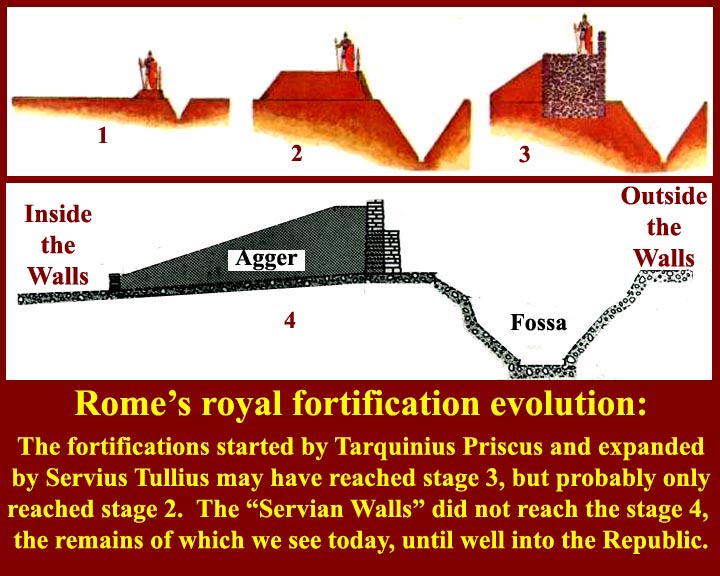

http://www.mmdtkw.org/AU0203mKings6bServianWalls.jpg
http://www.mmdtkw.org/AU0203nKings6cServianWall.JPG
Evolution of Rome's "agger and fossa" walls.
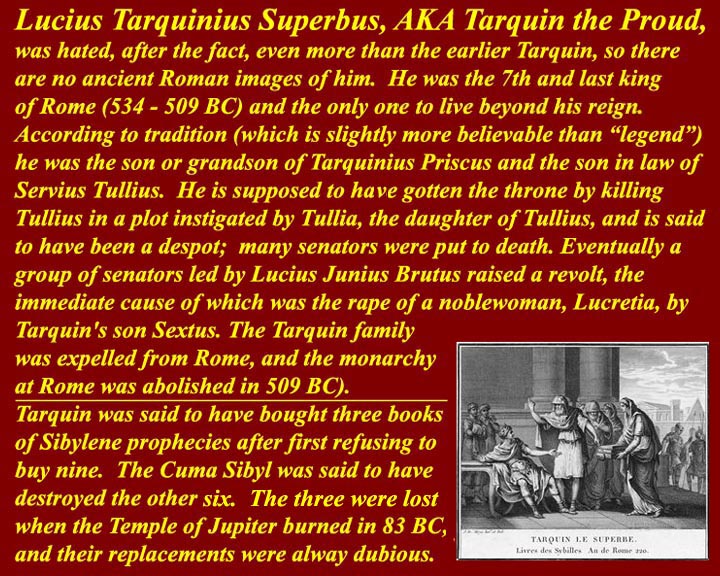
http://www.mmdtkw.org/AU0203oKings7aTarquinius Superbus.jpg
http://www.mmdtkw.org/AU0203pKings7bRapeLucretia.jpg
Tarquinius Superbus is said by some historians to be the same man as Tarquinius Priscus (and that's the important caveat mentioned above), but most think he was a separate and probably real person. It's important to know that his second name, which is often translated as "the proud" carried with it more than just a tinge of "the haughty". He rescinded the pro-plebeian reforms of Servius and courted the patricians. But even the patricians soon came to think that this second king named Tarquin was accumulating to himself and to his immediate circle too much power and privilege. His reign came unglued in 509 BC when one of his sons, Sextus Tarquinius, raped a Roman noblewoman named Lucretia. She assembled he family, told them what had happened, and then killed herself in front of them. Her brother, Lucius Junius Brutus, and he husband Lucius Tarquinius Collatinus led the mob that drove Tarquinius Superbus and his faction out of town. The sequal was the founding of the Roman Republic with L. Junius Brutus and L. Tarquinius Collatinus as the first Consuls.
L. Junius Brutus was the supposed ancestor of Marcus Junius Brutus (AKA Quintus Servilius Caepio Brutus, his adoptive name), who was supposedly persuaded to take part in the conspiracy to kill Julius Caesar in order to emulate his famous ancestor.
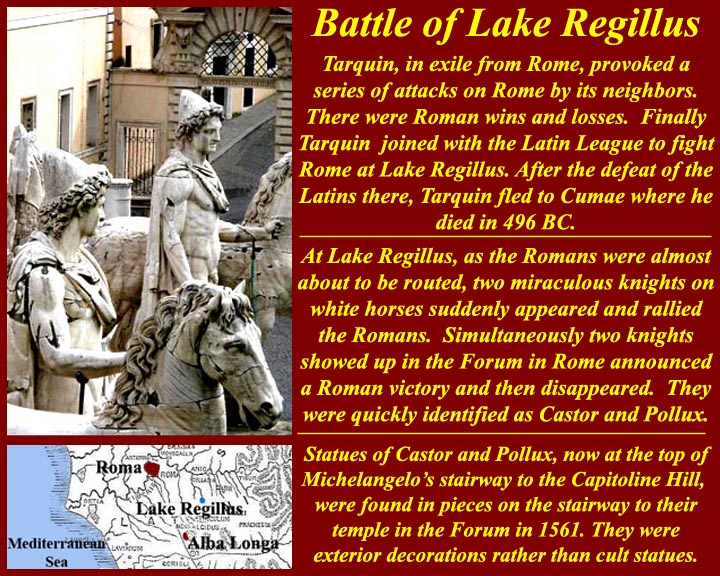
http://www.mmdtkw.org/AU0203qKings7cRegillus.jpg
http://www.mmdtkw.org/AU0203rKings7dJuturnaShrine.jpg
Tarquinius Superbus spent the next fifteen years plotting a comeback and enlisted the aid of groups that were enemies (victims?) of Rome. There were Roman victories and defeats, and Tarquin's campaign culminated in the Battle of Lake Regillus where the combined forces of the "Latin League" and of Tarquin faced off against the Romans. Near the end of the day, when the Romans appeared to be on the verge of defeat, two new armored knights ("equites") appeared on the field on white chargers. They rallied the Roman forces, and led them to victory and then disappeared. According to the legend, at the same time, two armored knights suddenly appeared in the Roman Forum and went to the sacred pool of Juturna where they watered their white horses. The people in the Forum, who were anxiously waiting for news of the battle, berated the knights for bringing their horses into the Forum and watering them at the sacred pool, but the knights quieted them with the news of the great Roman victory. And then they promptly disappeared. Comparing notes later, the Forum folks and the battle weary warriors decided that the two knights must have been Castor and Pollux. (In Greek mythology, they were the Dioskouroi (Διόσκουροι), Kastor and Polydeukes (Κάστωρ και Πολυδεύκης). In Roman mythology they were the Gemini (Latin, "twins") or Castores. Castor and Pollux, are the twin sons of Leda and the brothers of Helen of Troy and Clytemnestra. Castor means "beaver" in both Greek and Latin, and poludeukeis means "very sweet". In the myth the twins shared the same mother but had different fathers which meant that Pollux was immortal and Castor was mortal. When Castor died, Pollux asked Zeus to keep them together and they were transformed into the Gemini constellation.)
King Tarquinius Superbus is said to have died in exile in Cumae in 496 BC.
Coming out of the world of myth and back to the results of archeological and historical research:
It seems that a nondescript band of outcasts, or perhaps two bands, settled in and around what became Rome. The 753BC founding date for Rome was determined by adding together the lengths of the mythical reigns of seven supposed kings and adding that to the number of annual listed Consulships and to the length of known interludes and and counting backward. It is probably only coincidental that scientific archeological dating methods have determined that a small iron age settlement on the Palatine Hill dates from the middle of the 8th century BC.
The Romans at the end of the Republican period had built large houses near some earlier temples on the Palatine, and among the families that built there were the Julians -- Julius Caesar's family. (They reportedly had made their initial money by exploiting Palatine clays that were suitable for making Roman bricks.) During the excavations for the large late Republican Palatine houses, the builders found evidence of a much older settlement on the hill, and that evidence convinced the Romans of the late Republic that they had found the houses of their ancestors. The remains near the house of the paterfamilias of the Julian gens were identified as evidence that this family's mythical progenitor had lived on the hill -- and, in fact, they even reconstructed the ancient dwellings as a shrine. When the Julians (and Julio-Claudians) became the first imperial dynasty, they proselytized the cult of Romulus as part of the state religion.
The main source of information about the "foundation of Rome" is Livy's ab Urbe Condita which is mistakenly taken as a "primary source" of historical information, even though Livy himself continuously says that it is not, in his text. It's always important to remember that Livy wrote more than seven hundred years after the supposed founding of Rome and that he wrote it at a time when Augustus, the first of the ruling Julio-Claudians, was his main patron. Livy relies on earlier source material, but there are grave doubts about the possibility of unbiased sources for the monarchical period and about how Livy might have weighed the veracity of the sources he chose to use more than 700 years after the reign of Romulus. Modern historians, of course do the same thing: they choose, for example, which sources to which they will give credence for the reign of the real Macbeth of Scotland (about 1000 years after the fact), and we can only imagine what historians of 2000 years in our future will make of our current writings about Macbeth -- especially since the "history" was distorted by Shakespeare and by modern academia.
http://www.mmdtkw.org/AU0204aaTerramare.jpg
The Terramare culture, as mentioned in the first unit, was a precursor but not a predecessor of ancient Rome. That is, there is a clear break between the Terramare and Villanovan/Etruscan culture that followed it. Villanovan/Etruscan culture fed directly into the Roman culture.
http://www.mmdtkw.org/AU0204aVillanovaHouse.jpg
Villanovan (or early Etruscan) culture had clear parallels with earliest "architecture" and funerary art.
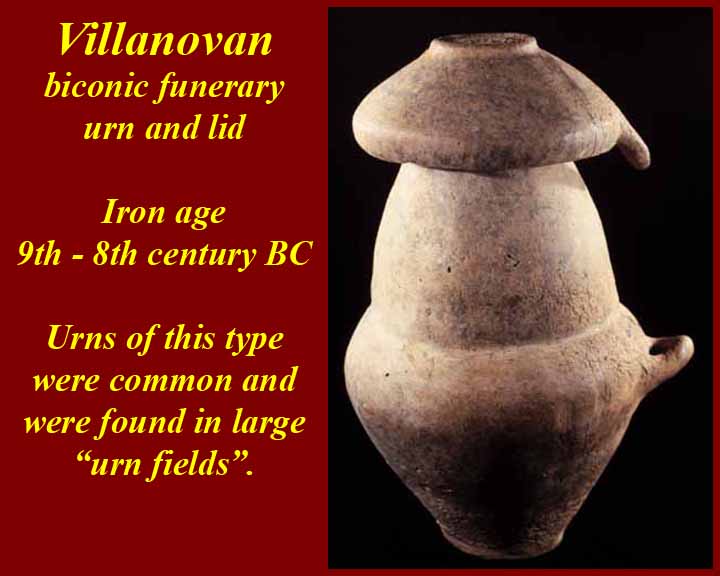
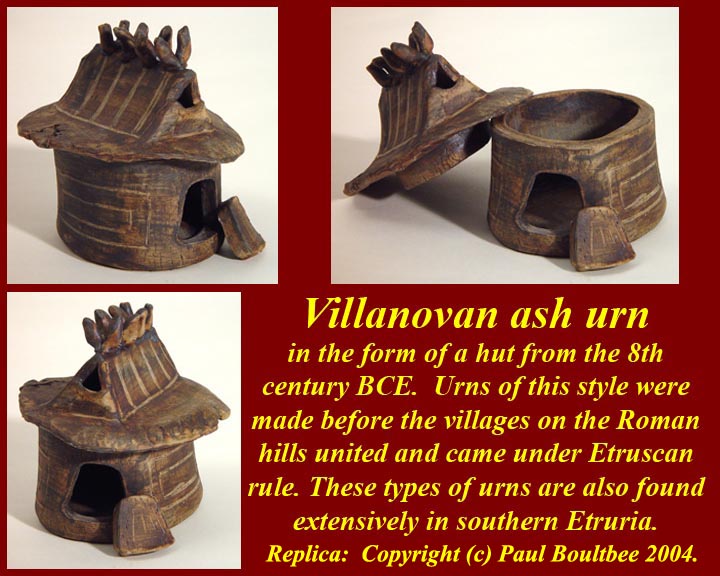
http://www.mmdtkw.org/AU0204bVillanovanCineraryUrn1.jpg
http://www.mmdtkw.org/AU0204cVillanovanCineraryUrn2.jpg
Replica: Copyright (c) Paul Boultbee 2004.
Villanovan/Etruscan cinerary urns resembled those of the Hallstadt culture in the French Alps. The urns shaped like houses look remarkably like the "Romulan" huts on the Palatine Hill.
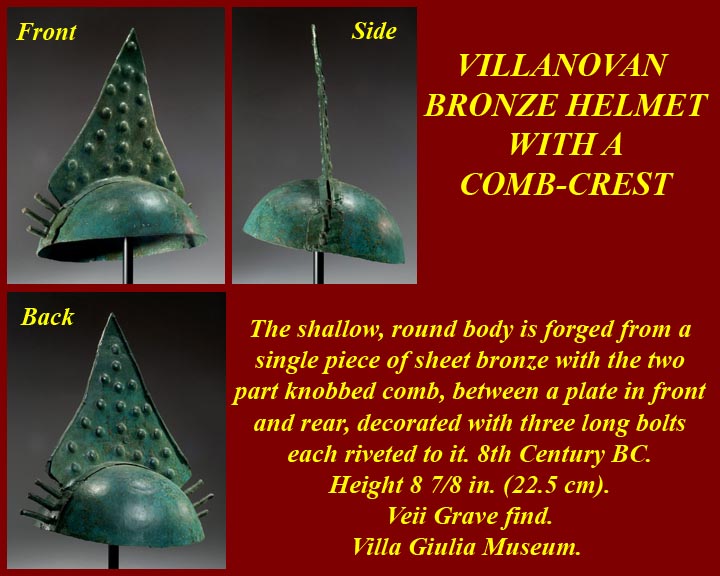
http://www.mmdtkw.org/AU0204dVillanovanHelmet.jpg
http://www.mmdtkw.org/AU0204eVillanovanShield.jpg
Even in the Villanovan (pre-orientalised) phase of Etruscan development, the Etruscans produced metal work the like of which the Romans were not to attain until the times of the Tarquin (Etruscan) monarchs.
http://www.mmdtkw.org/AU0205TumuliTomb.jpg
Rich Etruscan could expect a tumulus to be raised at the site of their interment. That type of tomb was used much later in Rome, e.g. the tombs of Augustus in the Campus Martius, and of Hadrian on the west bank if the Tiber (Castel Sant'Angelo).
http://www.mmdtkw.org/AU0206EtrusTerraCotta.jpg
The Etruscans famously used terracotta for funerary and religious art.
http://www.mmdtkw.org/AU0207aEtrusPottery.jpg
The most famous type of Etruscan pottery is the black bucchero which can be of two types: thin decorative ware or thick utilitarian. The blackness of the ware is a result of smokey firing, although there is also evidence that carbon black (lampblack or soot) was sometimes added to the clay to help achieve the blackness. Decoration of bucchero pottery was either incised of raised. The Etruscans also copied Greek red-figure and black-figure wares, and, for their richest grave offerings, the imported high end examples of pottery made in Greece. Since these imports were never used and were placed directly in Etruscan tombs, many of the best examples of Greek pottery are now in Italian museums. Greek pottery experts from all over the world, including from Greece, routinely visit the Vatican Etruscan Museum and the Villa Giulia Etruscan Museum in Rome to pursue studies of Greek pottery.
http://www.mmdtkw.org/AU0207bEtruscanBiccheroKantharos.jpg
Rome and its immediate surroundings are the findspots of many fine pieces of Etruscan bucchero ware. This elegant Bucchero kantharos, from the 3rd or 4th Latial Period is from tomb no. 62 at the cemetery of Osteria dell'Osa, near Rome.
http://www.mmdtkw.org/AU0208VillaInVulci.jpg
Few remains of Etruscan urban dwellings survived the general destruction and overbuilding by conquering Romans, but the Romans themselves wrote that the Roman urban atrial "Domus" was modeled after Etruscan architecture. Ex-urban villa ruins that survive are similar to Roman villas of later periods.
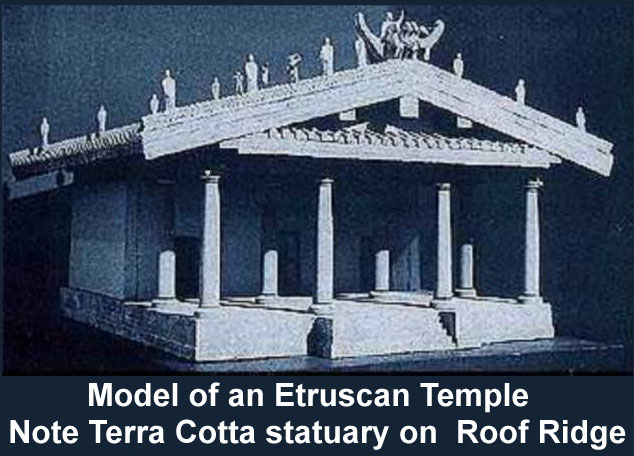
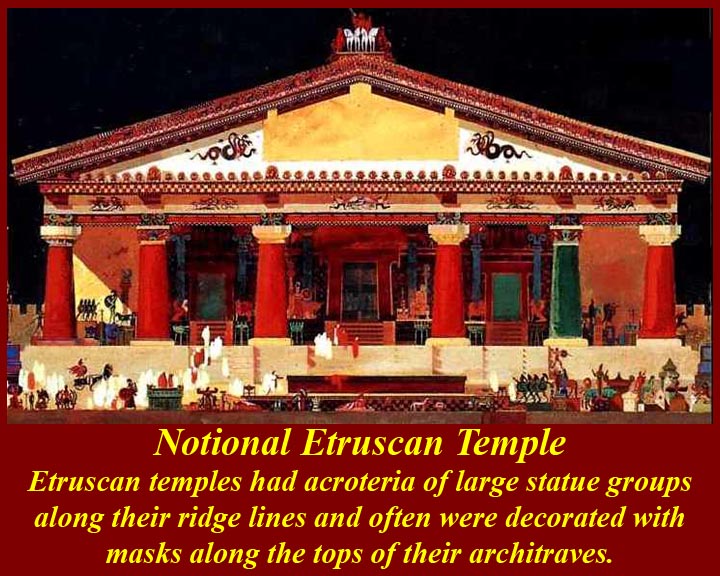
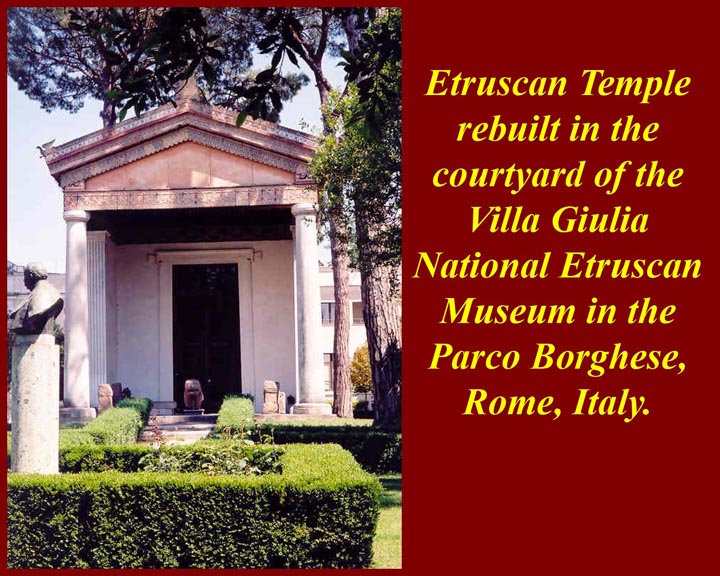
http://www.mmdtkw.org/AU0209aEtrusTempleModel.jpg
http://www.mmdtkw.org/AU0209bEtruscanTempleNotional.jpg
http://www.mmdtkw.org/AU0209cccEtruscanTempleVillaGiulia.jpg
http://www.mmdtkw.org/AU0209ccTempleJupiterCapitoline.jpg
Early Etruscan temples were neither Greek nor Roman in plan. They had wider frontage, and almost never had columns around the sides or back (they got to look more Greek after the "orientalizing" phase -- i.e., after more contact with and copying from the Greeks. Roman temples followed the same pattern of development. The 4th image shows a drawing of an early phase of the temple of Jupiter Optimus Maximus on the Capitoline Hill, looking very Etruscan. Not surprisingly, it was ascribed to Tarquinius Priscus, the fifth king of Rome and Rome's first Etruscan king. Later reconstructions of the temple (after fires caused by lightning) became more and more Greco-Roman.
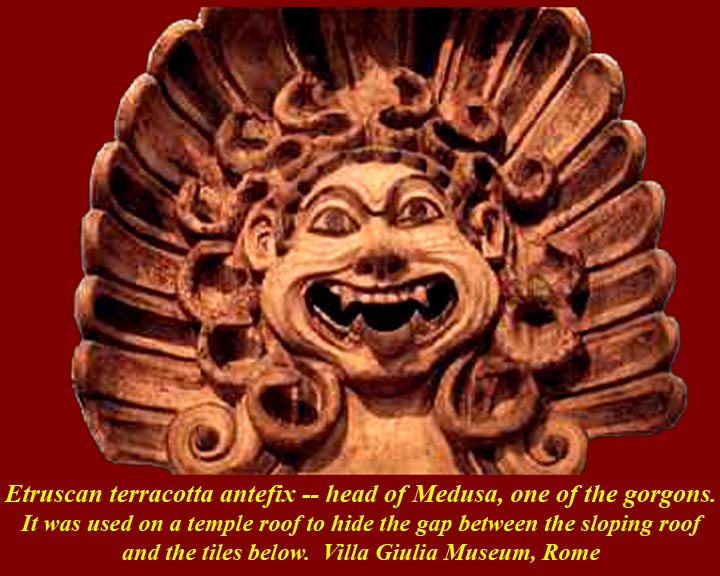
http://www.mmdtkw.org/AU0209cEtruscanAntefix1.jpg
http://www.mmdtkw.org/AU0209dcolorsculpture_zoom.jpg
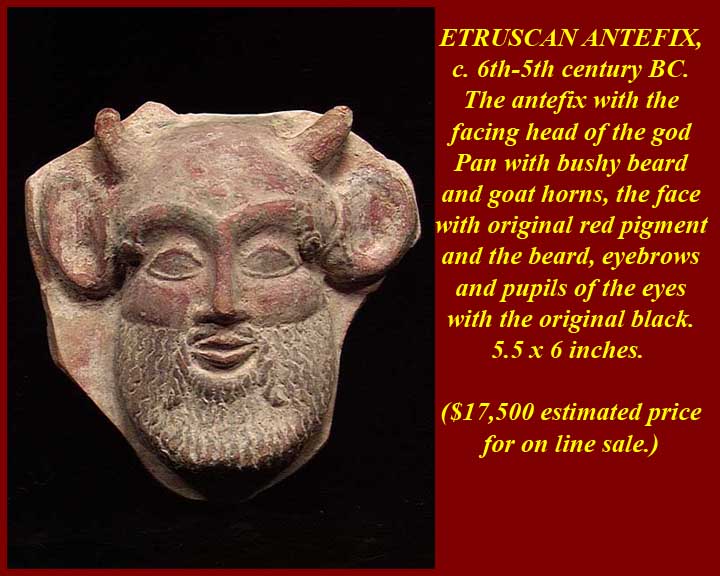
http://www.mmdtkw.org/AU0209eEtruscanAntefix2.jpg
http://www.mmdtkw.org/AU0209fEtruscanAntefix3.jpg
Antifixes on Etruscan temples served the same purpose as gargoyles on later Christian cathedrals. They were spouts through which rainwater flowed. They not only prevented water stains and discoloration of painted surfaces, but they also helped maintain the structural integrity of the buildings on which they were mounted by preventing rot in wooden parts of the buildings and by not letting water flow down through their brick and/or stone walls.
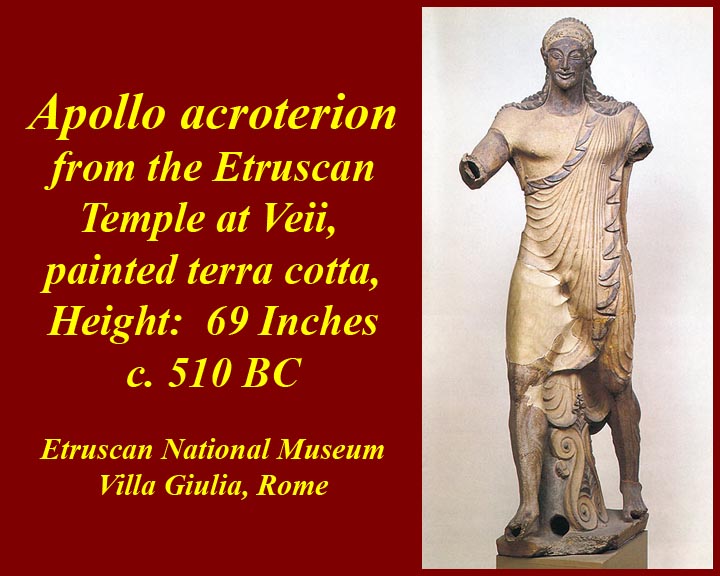
http://www.mmdtkw.org/AU0209gEtruscanApolloAcroterion.jpg
http://www.mmdtkw.org/AU0209hEtruscanWingedHorses.jpg
Terracotta acroteria were mounted on the top of temple ridgelines and terracotta reliefs were mounted on the front of main temple beams. The chariot they pulled, which was affixed to the next panel of the Tarquinia temple was not recovered.

http://www.mmdtkw.org/AU0210CasaRomuli.jpg
http://www.mmdtkw.org/AU0211RomHutVillage.jpg
Primitive huts in the "Romulus" village on the Palatine Hill.
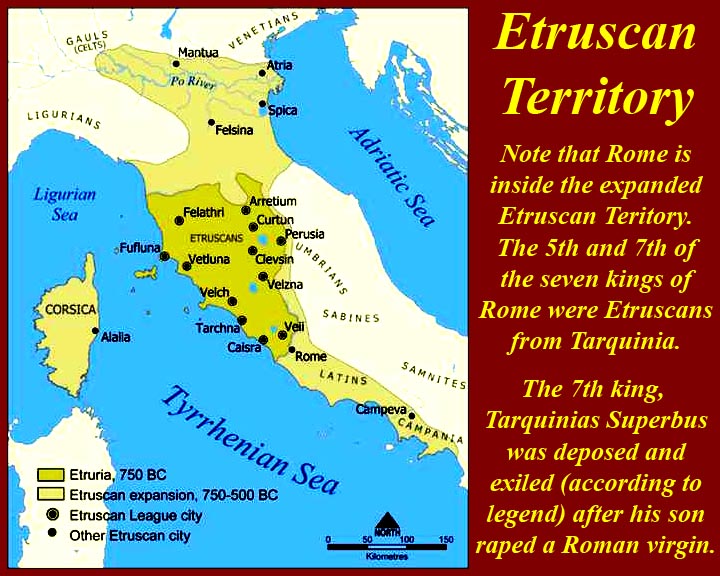
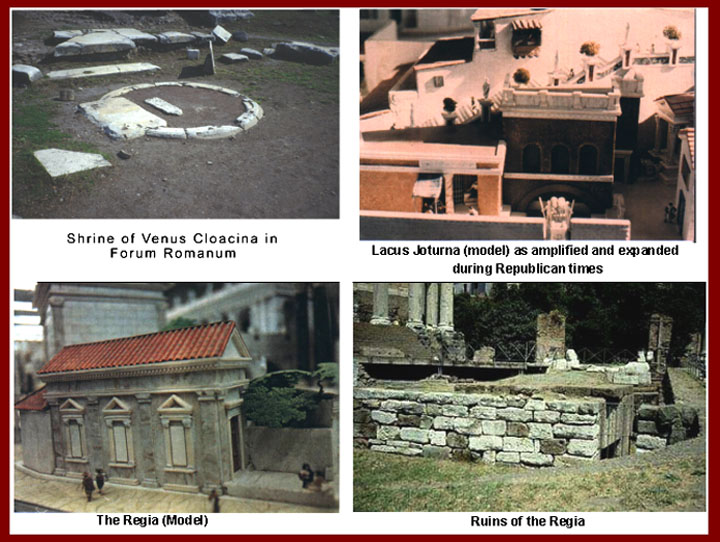
http://www.mmdtkw.org/AU0212EtruscanVivilizationMap.jpg
http://www.mmdtkw.org/AU0213MonarchRemainsForum.jpg
http://www.mmdtkw.org/AU0214Regia.jpg
Rome was essentially part of Etruscan territory during the Etruscan Latial (i.e., Latium-inclusive) periods. There are still some Etruscan remains in the Roman Forum area that survived later rebuildings, but they are mostly just deep foundations. One example, from which we can infer some details of Etruscan domestic architecture is the ruins of the "Regia", the early stages of which, represented now just by foundations, were built by the Etruscan kings of Rome as their residence. After the end of the monarchic period, the Regia became the house of the Pontifex Maximus (the "High Priest"). When Augustus became Pontifex Maximus at the death of Marcus Aemilius Lepidus in 12 BC, he moved the official residence of the Pontifex Maximus to the Palatine and built there another Temple of Vesta. Among other duties the Pontifex Maximus was the protector of the Vestals. The official hearth of Rome and Vesta's sacred fire was thus protected in two separate Temples. The old Regia was transferred to the House of the Vestals (next to the Vesta Temple down in the Forum) and was used thereafter as a VIP guest house.
http://www.mmdtkw.org/AU0215EtruscanChariot.jpg
Romans modeled their war chariots on Etruscan models, but used them only for a short time in war and thereafter for ceremonial purposes. The Roman army moved on foot, with some officers on horseback. The mounted knights of the monarchy virtually disappeared in later periods. A general or consular theater commander and his immediate personal staff might be the only mounted Romans in battles. There were cavalry troops, but they were almost all foreign auxiliaries, and their top officers, mounted Romans, were the only exceptions.
Chariots were "war weapons" and were only allowed inside the Pomerium of any Roman city during an official "triumph" when the victorious general rode through the Forum on the Via Triumphalis. So those ruts in Roman city streets were never really worn by chariot wheels -- in fact the ruts were purposely chiseled into the roads to keep ox carts on track. (See http://www.mmdtkw.org/ALRIVes0302Ruts1.jpg.)
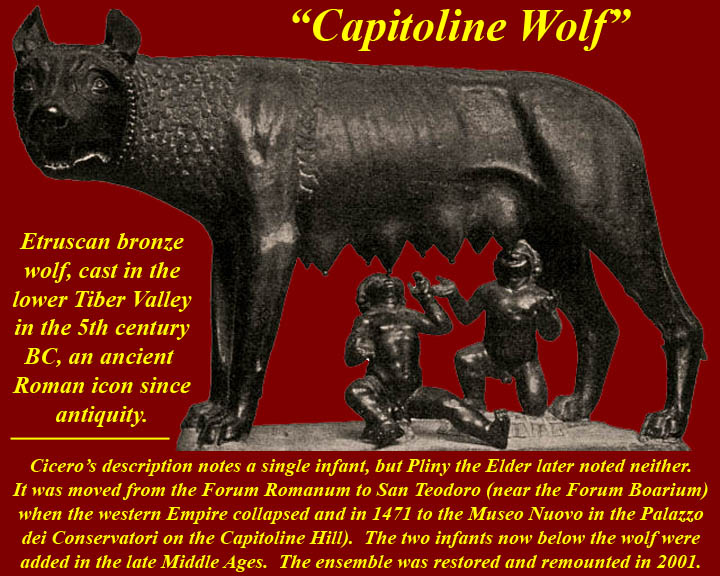
http://www.mmdtkw.org/AU0216EtruscanCapitolineWolf.jpg
http://www.mmdtkw.org/AU0217EtruscanChimera.jpg
Even the most Roman of images, the Capitoline Wolf was actually Etruscan. The two babes, representing Romulus and Remus are renaissance additions. The Chimera in the second image is a much more complicated composite bronze casting than the wolf
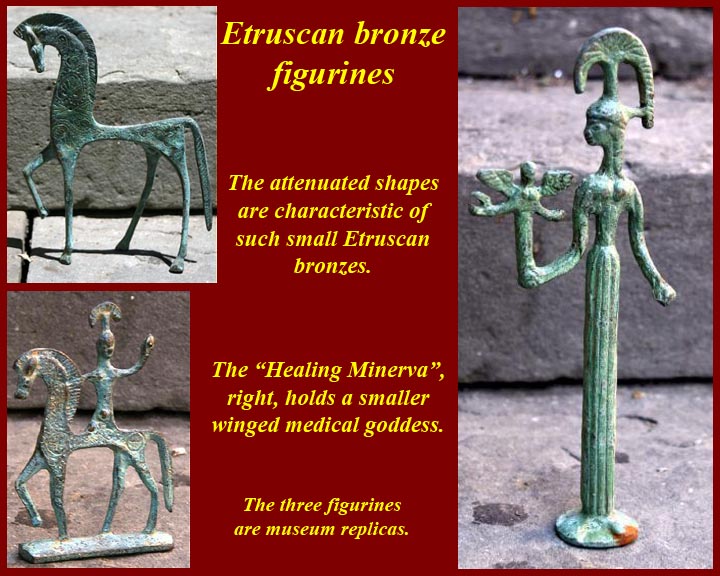
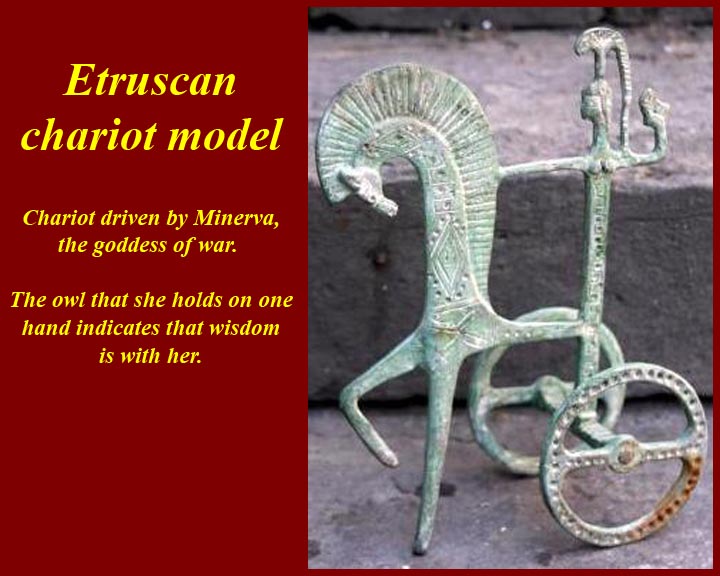
http://www.mmdtkw.org/AU0218EtruscanBronzeDancer.jpg
http://www.mmdtkw.org/AU0219EtruscanCaharioModel.jpg
http://www.mmdtkw.org/AU0220EtruscanFigurines.jpg
http://www.mmdtkw.org/AU0221EtruscanCeremonialHelmet.jpg
By the time the Romans learned how to cast bronze and accumulated enough wealth to buy bulk bronze for casting, Etruscan attenuated figures were out of style, and more naturalistic Greek ("orientalized Etruscan") styles were copied.
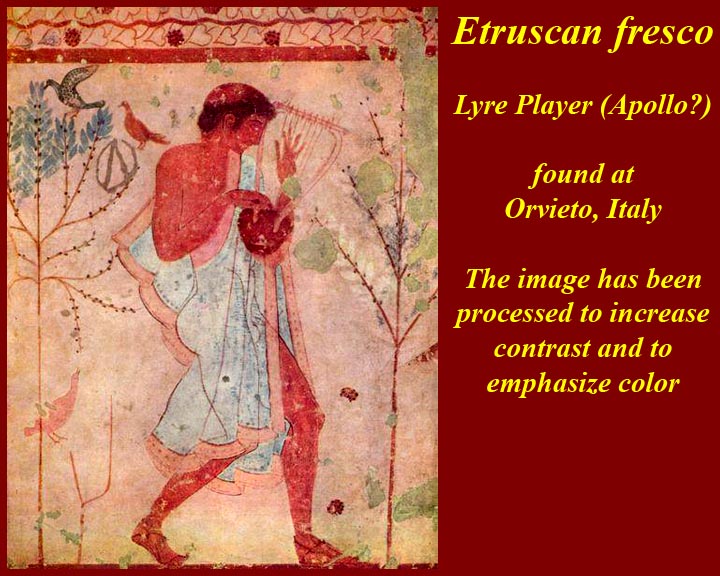
http://www.mmdtkw.org/AU0222EtruscanFresco1.jpg
http://www.mmdtkw.org/AU0223EtruscanFresco2.jpg
Etruscan fresco work was also clearly the source of early Roman works. In later times (i.e., Republic and Empire) the Romans copied directly from the Greeks, although Roman vernacular ("vulgar") art developed alongside upper class copying.
http://www.mmdtkw.org/AU0224EtruscanCippus.jpg
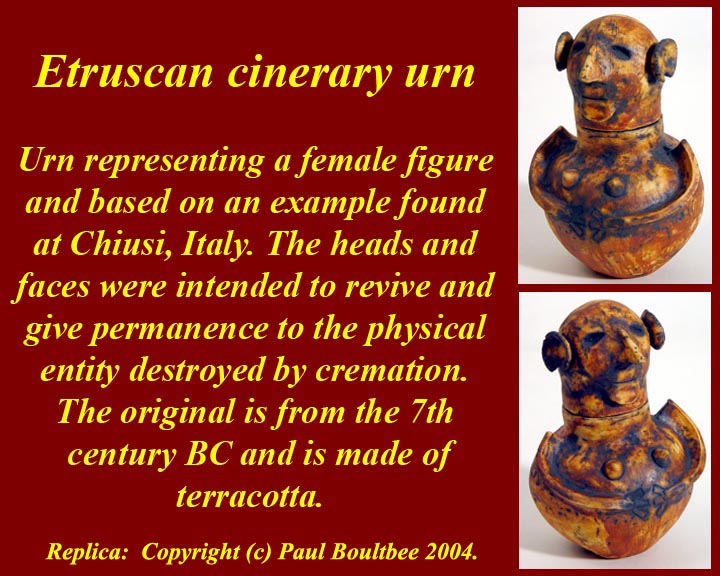
http://www.mmdtkw.org/AU0225EtruscanCineraryUrn1.jpg
Replica: Copyright (c) Paul Boultbee 2004.
http://www.mmdtkw.org/AU0226EtruscanCineraryUrn2.jpg
Replica: Copyright (c) Paul Boultbee 2004.
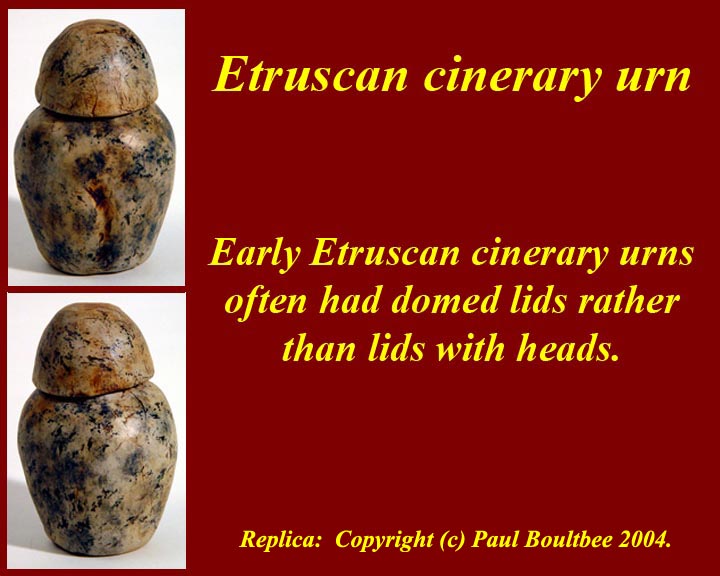
http://www.mmdtkw.org/AU0227EtruscanCineraryUrn3.jpg
Replica: Copyright (c) Paul Boultbee 2004.http://www.mmdtkw.org/AU0228EtruscanCineraryUrn5Mask.jpg
Replica: Copyright (c) Paul Boultbee 2004.
http://www.mmdtkw.org/AU0229EtruscanCineraryUrn4.jpg
Replica: Copyright (c) Paul Boultbee 2004.
http://www.mmdtkw.org/AU0230EtruscanCineraryUrn6.jpg
http://www.mmdtkw.org/AU0231EtruscanSarcophagus.jpg
Etruscan funerary art similar to these pieces, which are all from Etruscan cemeteries, do occasionally show up in and around Rome, but they are usually from graves that are just classified as Etruscan.
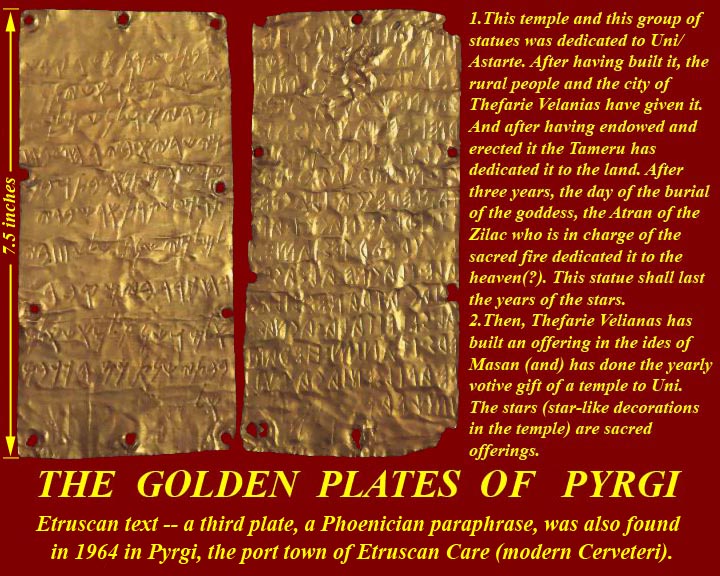
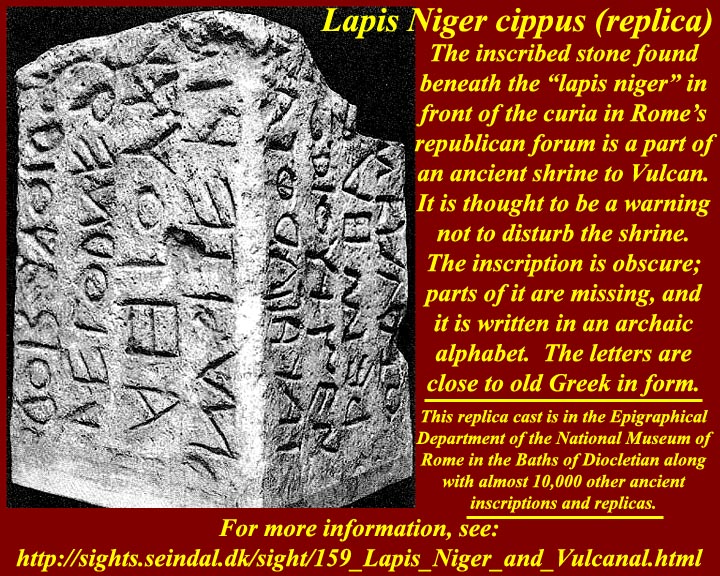
http://www.mmdtkw.org/AU0232GoldenPyrgiPlates.jpg
http://www.mmdtkw.org/AU0104bLapisNigeCippus.jpg
http://www.mmdtkw.org/AU0233LapisNiger.jpg
The archaic Roman alphabet on the Lapis Niger is very similar to the Etruscan alphabet used in the Pyrgi gold plates (which are in the Villa Giulia National Etruscan Museum, Villa Borghese, Rome), but the languages -- vocabulary, pronunciation and grammar -- are not the same. English and French are written in the same alphabet, but if you don't know French vocabulary and pronunciation you won't be able to understand or even pronounce the French text. Ancient Etruscan is still not fully understood. The problem is limited vocabulary: virtually all that we have of Etruscan is grave inscriptions and prayers, so there is not enough vocabulary to reconstruct the language.
It's not known if the Roman alphabet was derived from the Etruscan or perhaps directly from the archaic Greek alphabet that was used in the Greek colonies of Magna Graecia.
http://www.mmdtkw.org/AU0234viteliuLogo.jpg
The Etruscans called themselves Rasenna and called their homeland Hiteliu. Hiteliu is assumed to be the source of the Roman and Italian word Italia and of the English version, Italy.

